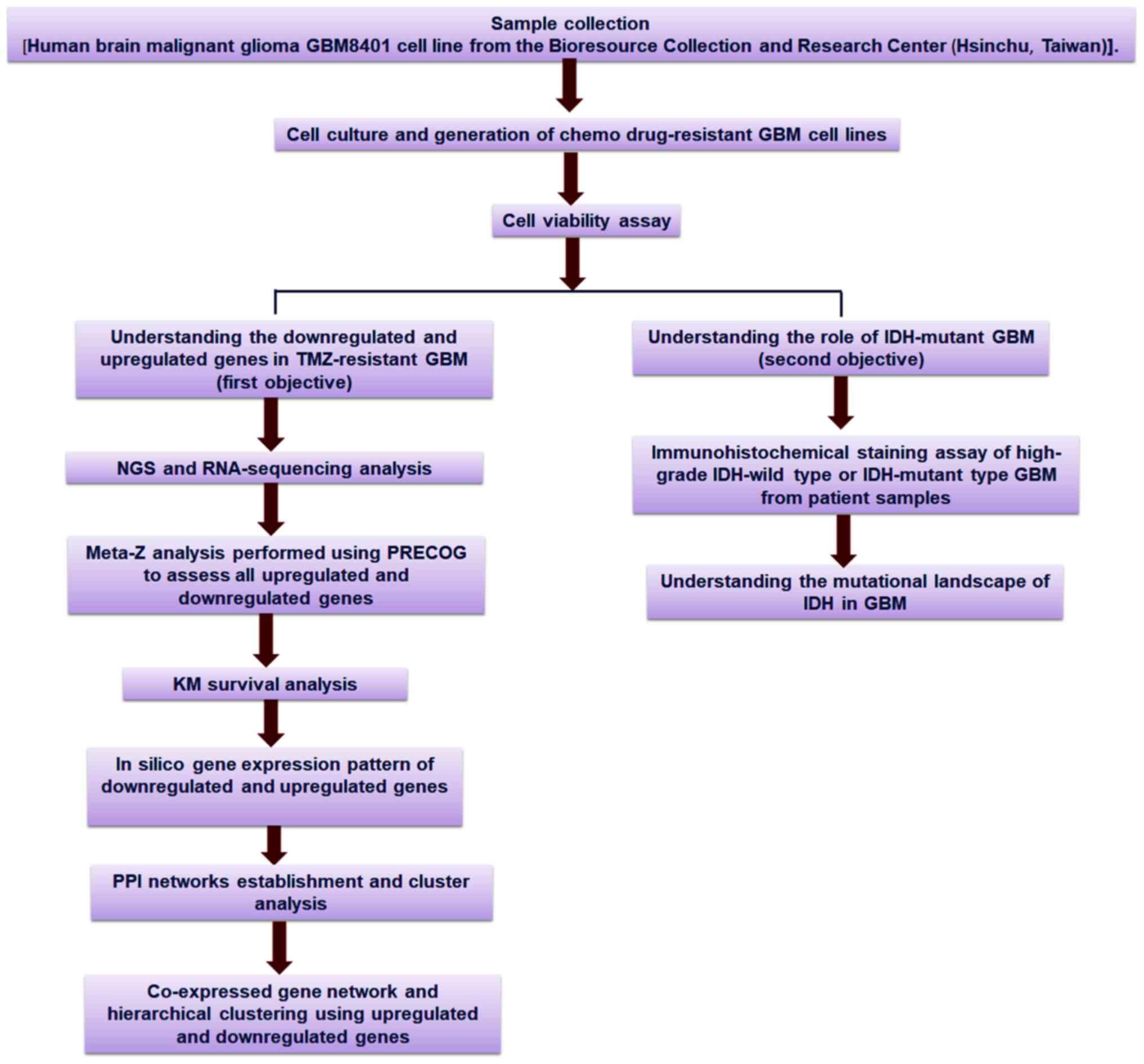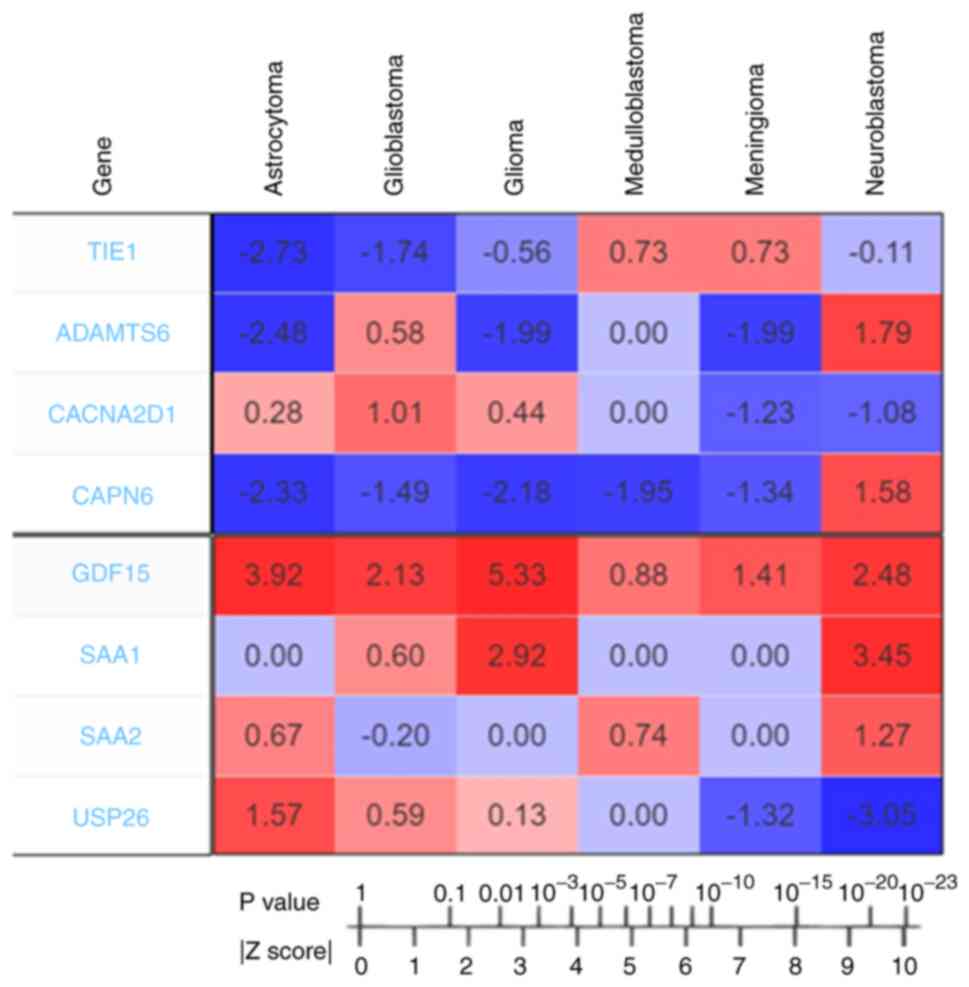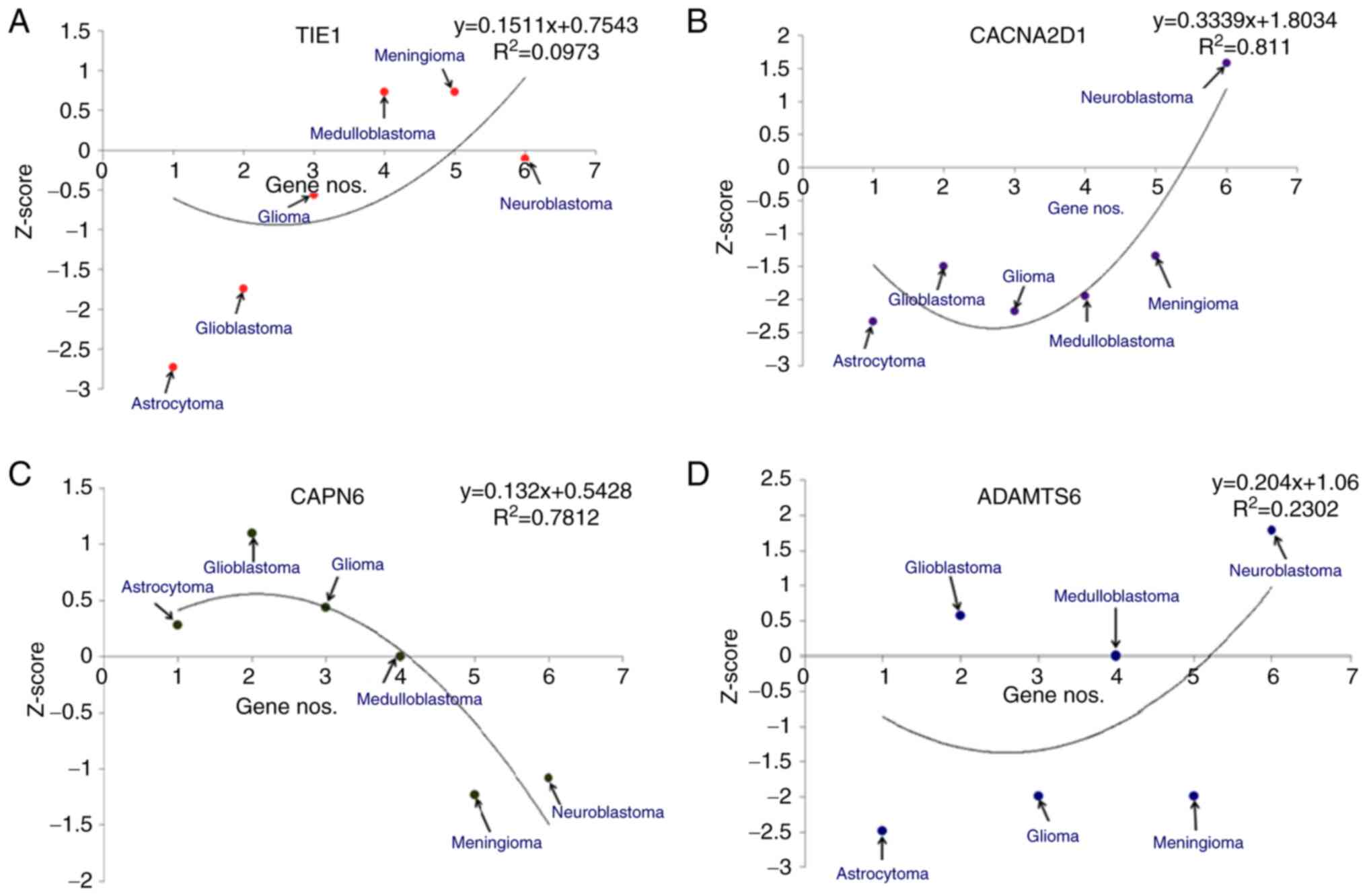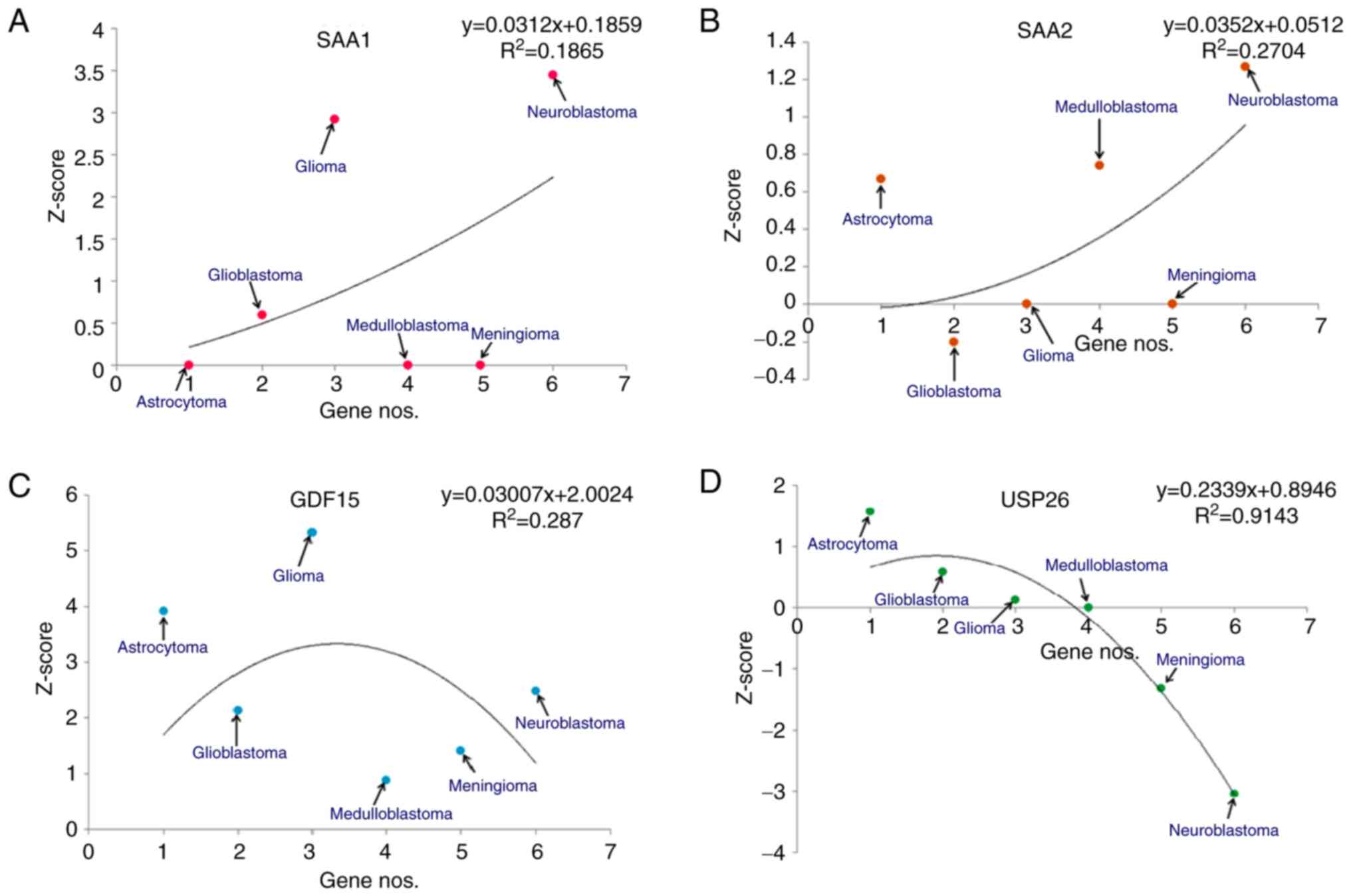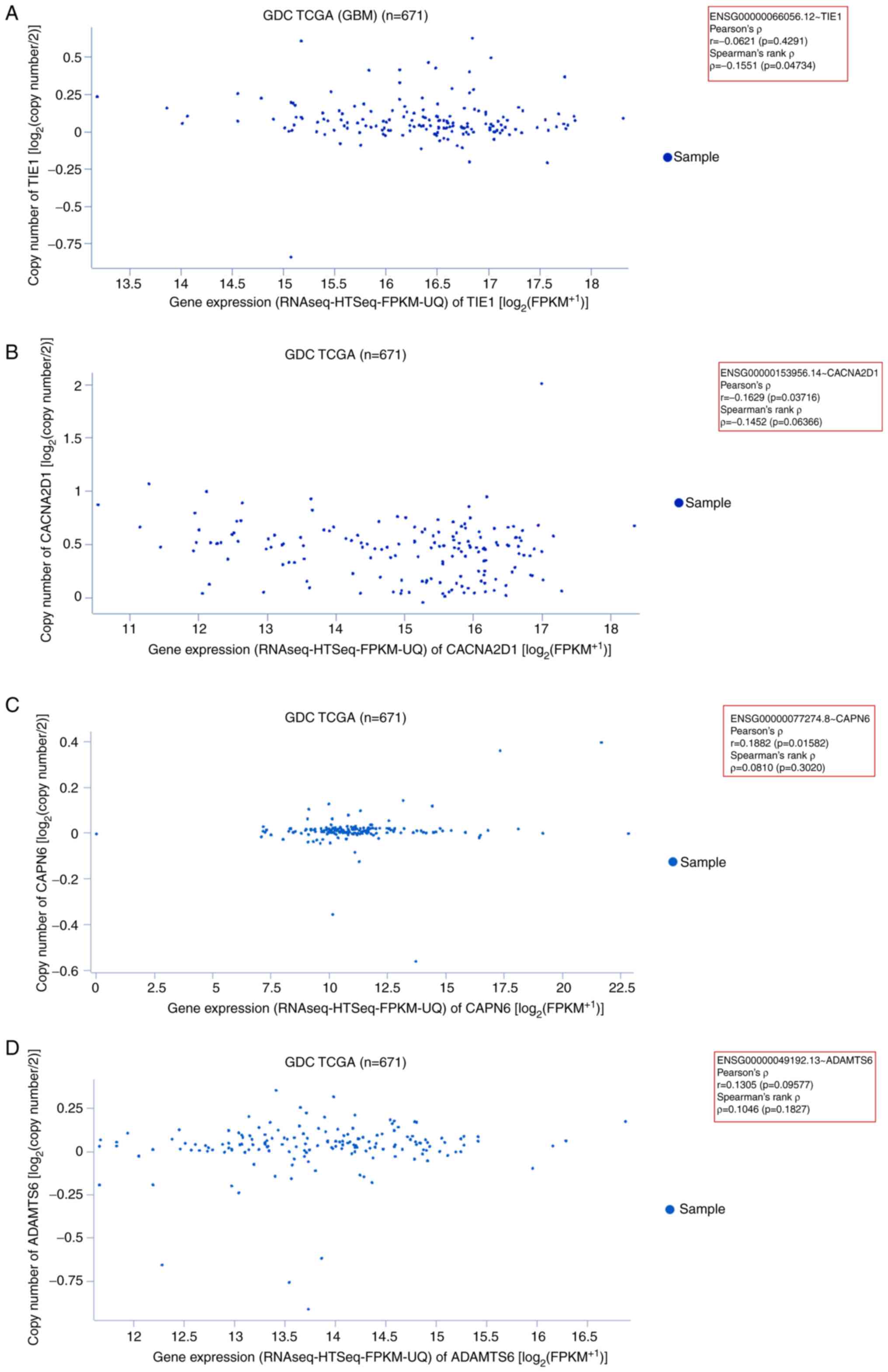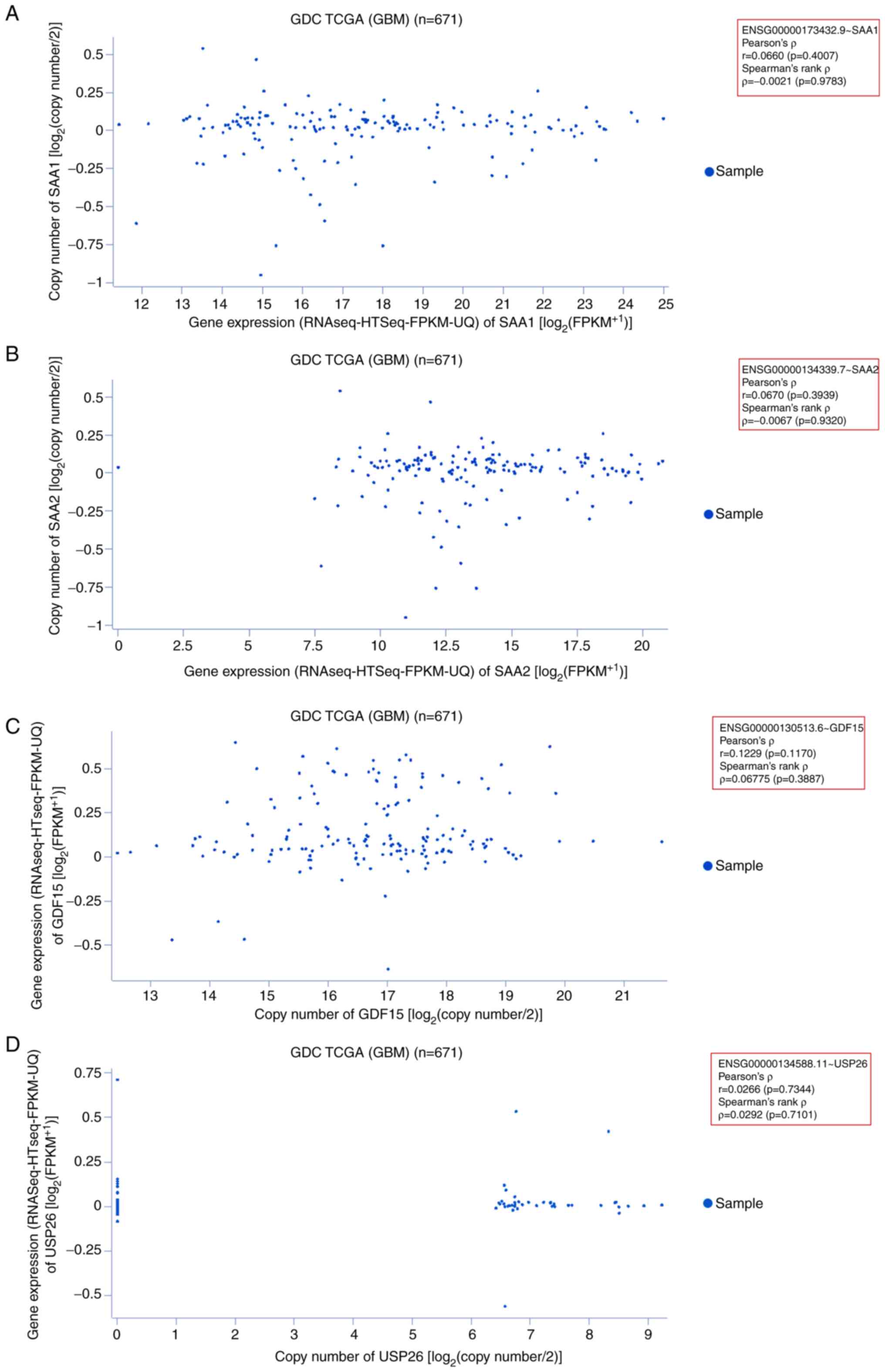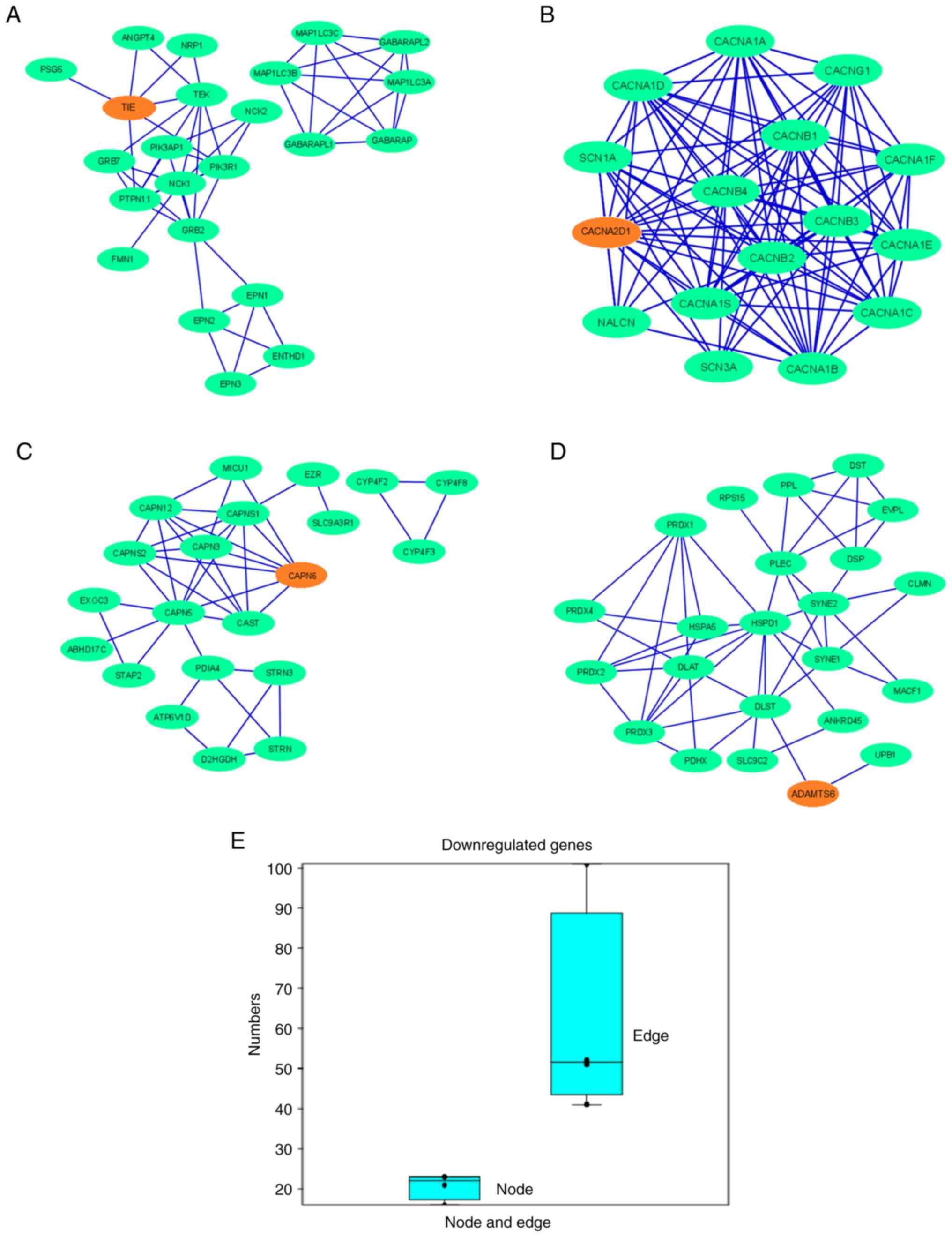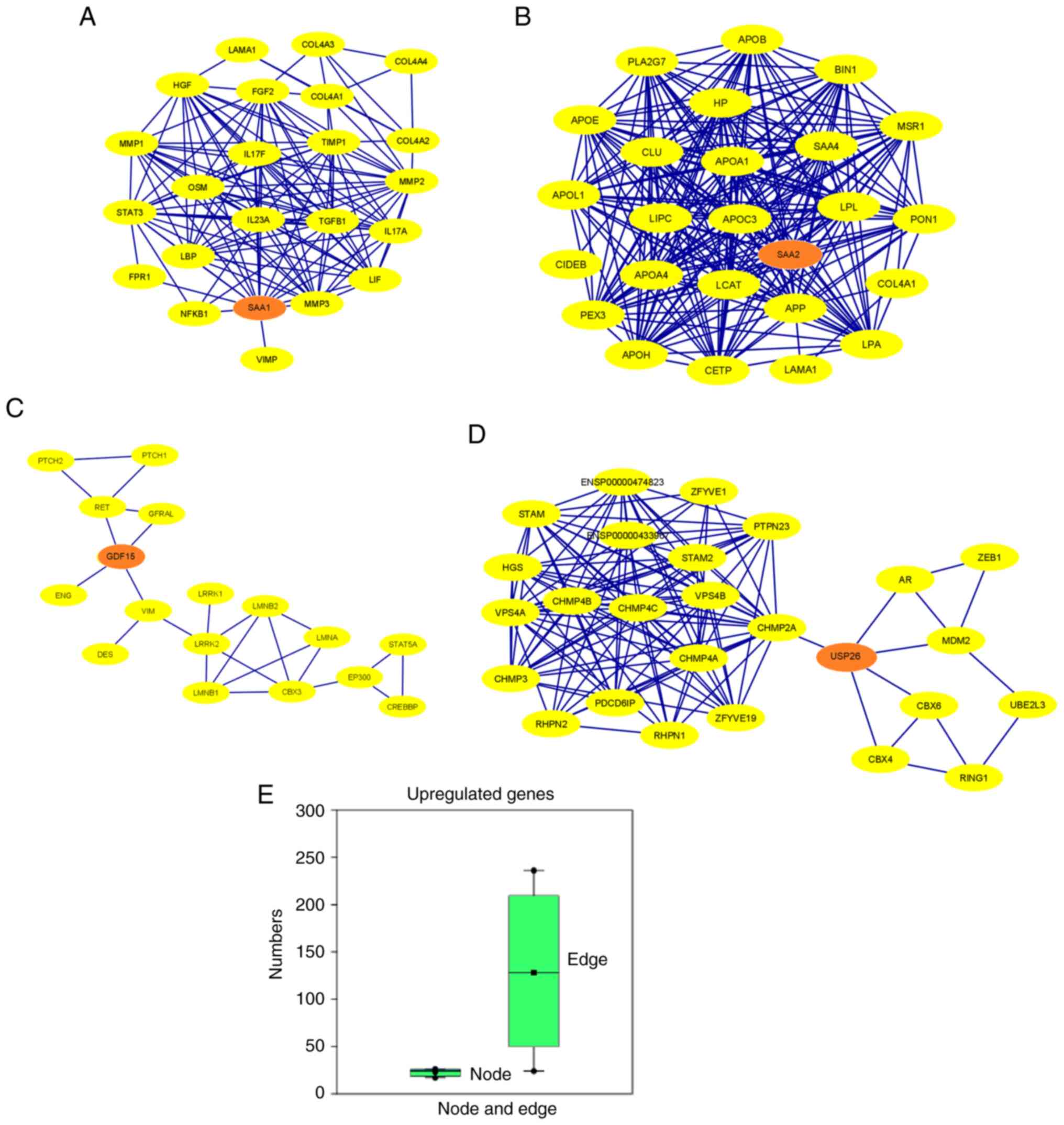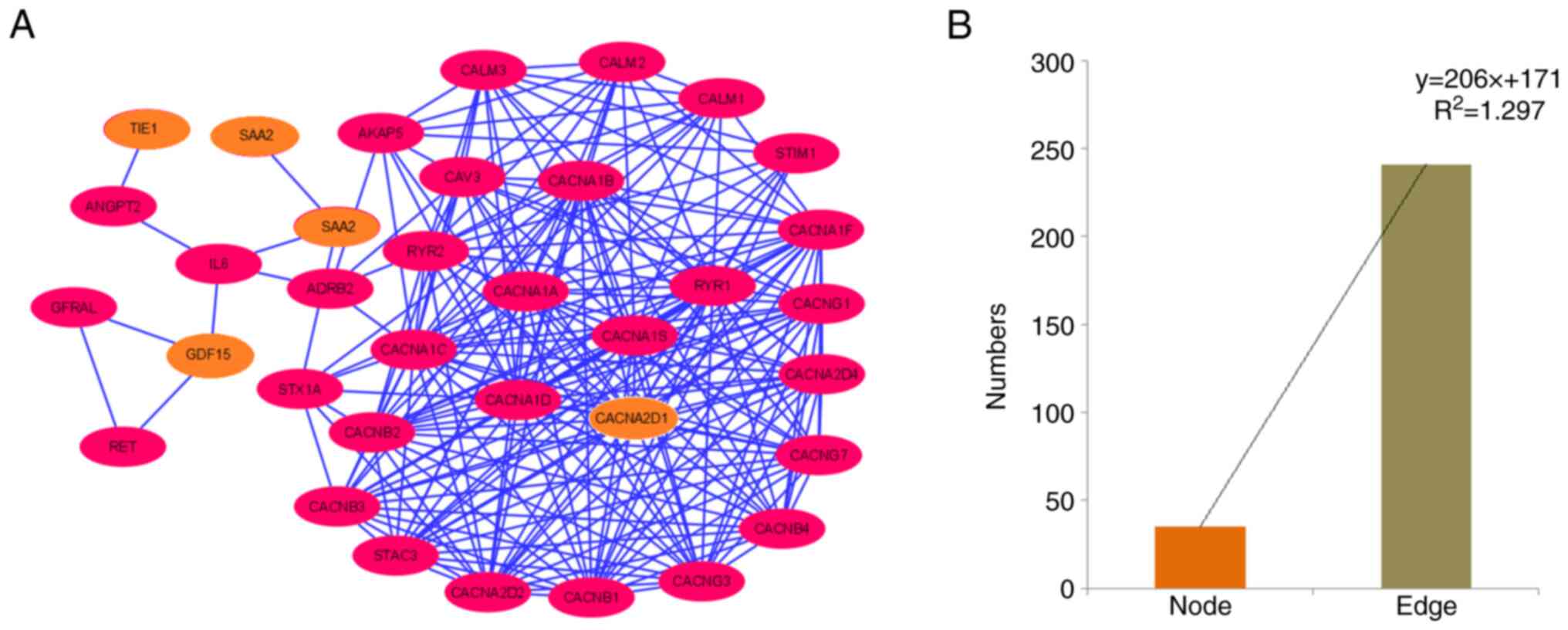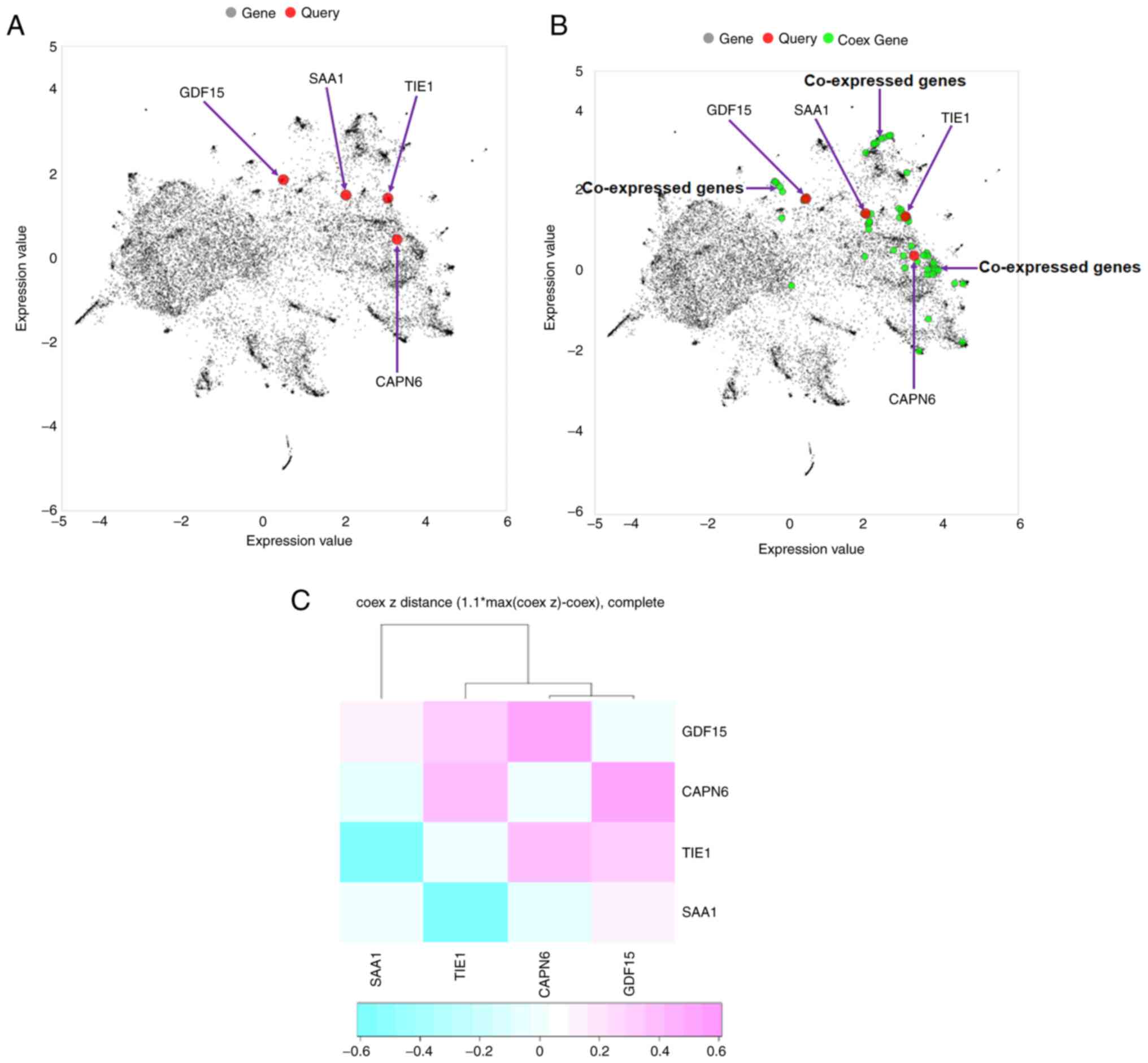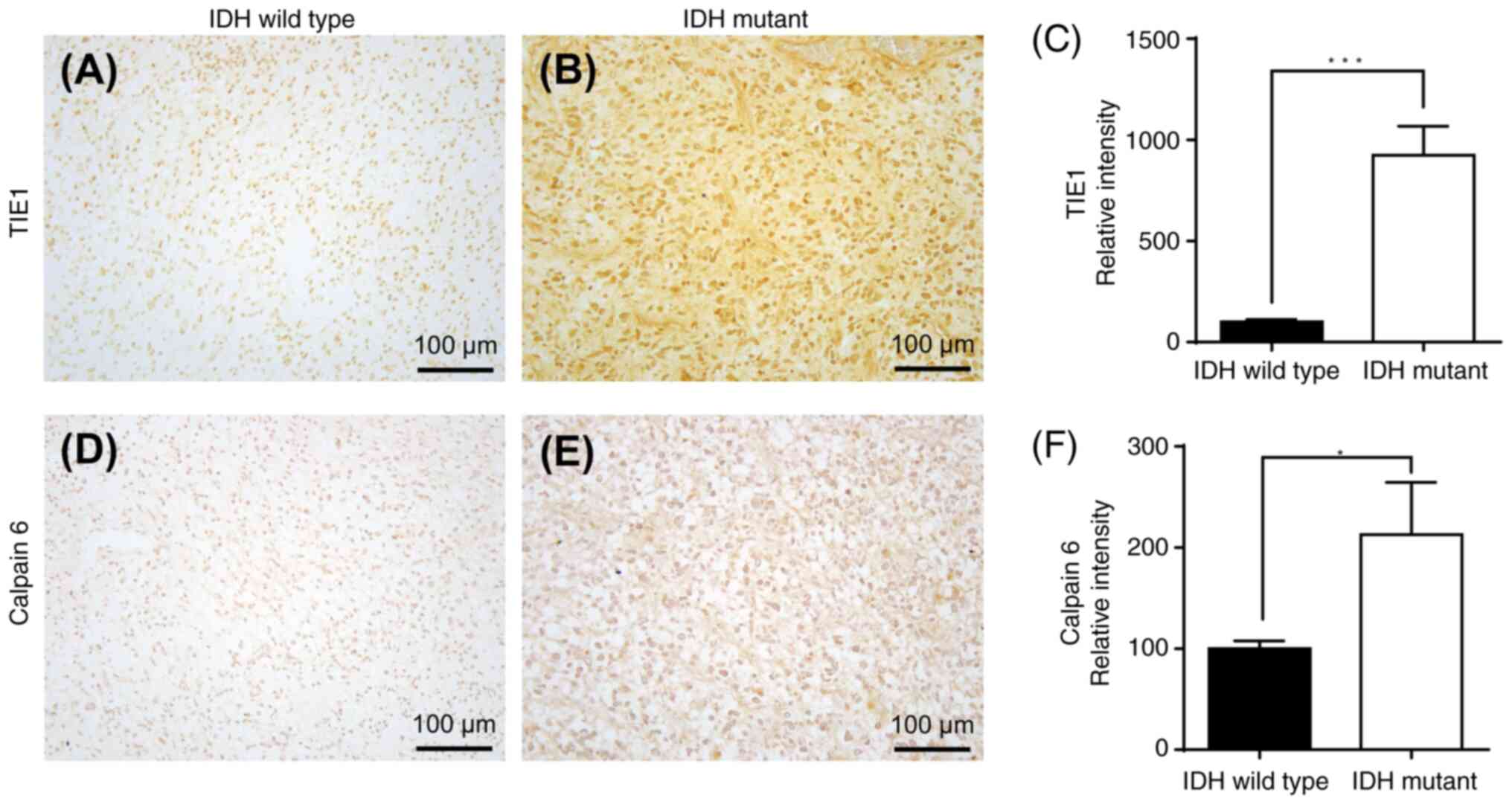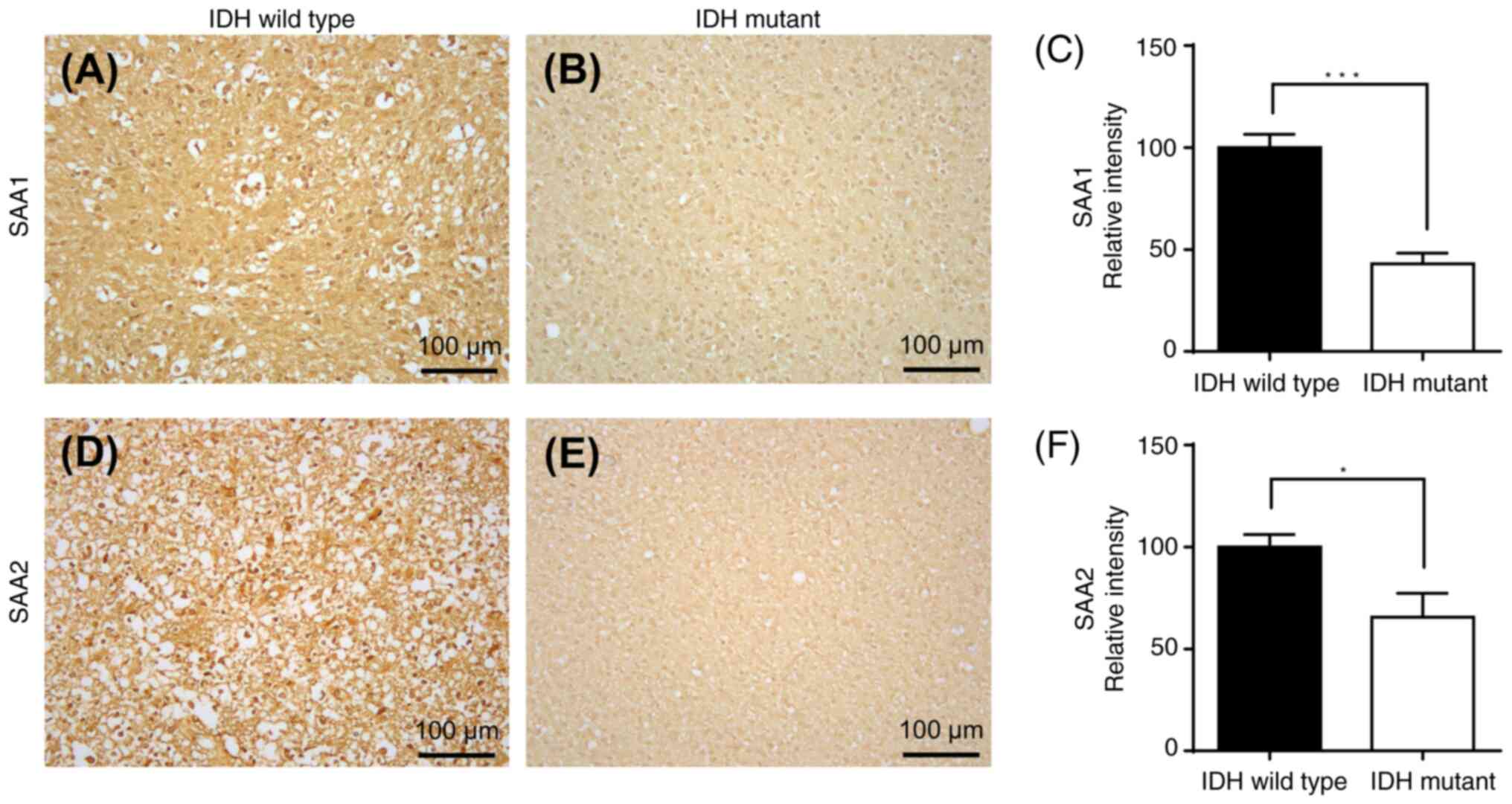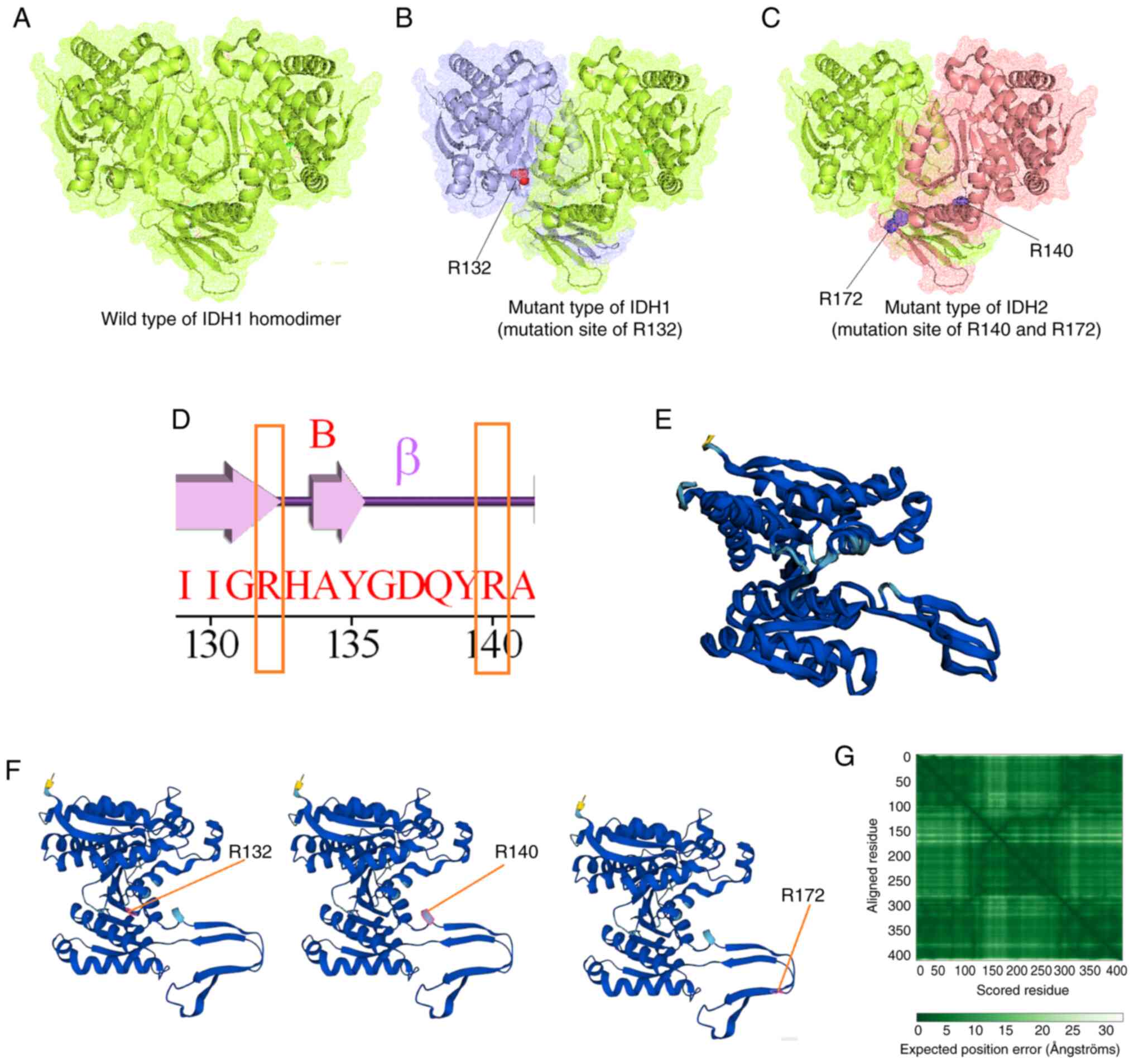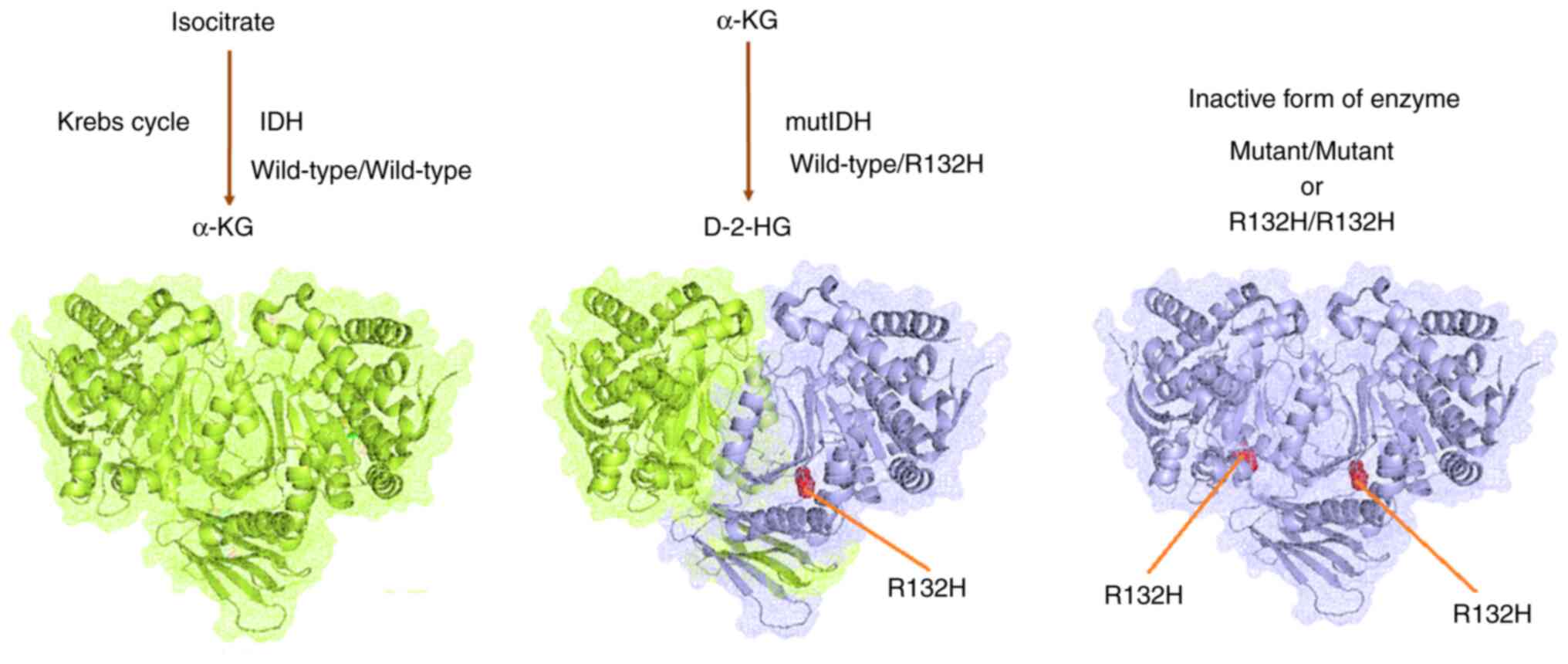Gene expression profiling and the isocitrate dehydrogenase mutational landscape of temozolomide‑resistant glioblastoma
- Authors:
- Published online on: June 17, 2024 https://doi.org/10.3892/ol.2024.14511
- Article Number: 378
-
Copyright: © Chen et al. This is an open access article distributed under the terms of Creative Commons Attribution License.
Abstract
Introduction
Malignant and non-malignant tumors of the central nervous system, including the brain, are a burden to society. They are diagnosed at a rate of 0.55 per 0.1 million individuals in a range of countries (1); however, malignancy is unusual in the USA and accounts for an unequal burden of cancer mortality owing to its augmented fatality rate (2). An average annual mortality rate of 4.43 per 100,000 individuals was recorded in those with malignant CNS tumors (3). Among these tumors, several types are gliomas, which are classified as malignant transformations of glial cells. Researchers have noted the occurrence of malignant gliomas in ~5 cases per 1 million people (4). It has also been observed that the considerable mortality and morbidity rates associated with malignant gliomas are due to inadequate treatment efficacy and the use of aggressive therapies in the USA (5). During the calculation of glioma mortality from 1995 to 2018, it was noted that the rate declined by 0.4% per year, but an increased mortality rate was observed in older adults >80 years of age (6). On the other hand, Upadhyaya et al (7) found that high-grade glioma contributed to 66% of the mortality in the children population.
Glioblastoma multiforme (GBM) is a type of glioma and central nervous system tumor that can originate from ≥3 possible precursor cells: Neural stem cells (NSC), NSC-derived astrocytes and oligodendrocyte precursor cells (8). Based on their growth, gliomas were categorized into four groups (grades 1-4). Grade 4 astrocytomas are also known as GBMs. According to the World Health Organization (WHO), GBM constitutes ~16% of all brain tumors and 54% of all gliomas (9). Stupp et al (10) developed a standard protocol, the addition of temozolomide (TMZ) to radiotherapy (RT), for treating GBMs, which is followed by many clinicians. The tumors are surgically resected according to this protocol. Subsequently, postoperative ionizing radiation is applied alongside adjuvant temozolomide chemotherapy (10). Ionizing radiation and chemotherapy act through common pathways that induce DNA damage and cell death. They can act directly or indirectly by generating reactive oxygen species (11).
However, multidrug resistance (MDR) limits advancements in the treatment of brain tumors. MDR is a significant global problem associated with a series of processes that primarily account for chemotherapeutic drug resistance (12). Glutathione S-transferase is a group of multifunctional proteins involved in MDR. These enzymes belong to a superfamily of detoxification enzymes (13). Therefore, it is necessary to study MDR patterns in brain cancers such as GBMs, gliomas, medulloblastomas and neuroblastomas. GBMs are highly resistant to most treatments owing to their cellular heterogeneity (14). Intense clonal plasticity has also been reported. Moreover, cancer stem cells may inhibit TMZ- and RT-induced cell death (15). Thus, it is necessary to further understand GBM-associated genes and their role in chemotherapy resistance.
Several studies have reported that gene expression is responsible for MDR and chemoresistance in brain tumors (16–18). Studies have investigated alterations in the gene expression profiles of several types of brain tumors under different therapeutic conditions. Ngo and Harley assessed the global gene expression profile alterations in GBMs during therapy with the antineoplastic drug TMZ. Yao et al (19) illustrated the gene expression profiles of GBM resistance and identified two candidate genes, Fanconi anemia complementation group D2 and squalene epoxidase, linked to ferroptosis-related chemoresistance in GBMs. Nevertheless, there is a knowledge gap in the gene expression profiling of TMZ-resistant GBM and it is necessary to understand the gene expression profiles of drug-resistant GBM cell lines. Therefore, the present study aimed to assess the downregulated and upregulated genes in TMZ-resistant GBM. Previous studies have discussed the role of different mutations in TMZ-resistant GBM, such as anaplastic lymphoma kinase mutations (20). In contrast, O6-methylguanine-DNA methyltransferase overexpression is widely used as a biomarker to predict which patients with GBM will be unsuitable for TMZ treatment (21).
The WHO has classified GBM into two types: Isocitrate dehydrogenase (IDH)-wild-type and IDH-mutant, which possess different genetic, epigenetic and transcriptional characteristics (22). Several studies have reported that patients with IDH-mutant GBMs have improved outcomes after TMZ treatment (23). Therefore, an enhanced understanding of the IDH mutational landscape in TMZ-resistant GBM cells is required. Therefore, the present study aimed to assess the IDH mutational landscape in TMZ-resistant GBMs.
Mutations in IDH are significant factors associated with several human malignancies. Three IDH isoforms are present in humans: IDH1 is found in peroxisomes and the cytoplasm, whereas IDH2 and IDH3 are found in the mitochondrial matrix (20,24). Han et al (24) described the potential molecular mechanisms underlying IDH mutations in gliomas. Wild-type IDH enzymes (IDH1 and IDH2) transform isocitrate into α-ketoglutarate (α-KG), reducing NAD(P)+ to NAD(P)H in the Krebs cycle. The IDH heterodimer is found in cells; thus, wild-type IDH serves a significant role in the Krebs cycle and exhibits regular activity. However, a mutation in one part of the IDH heterodimer produces D-(R)-2-hydroxyglutarate (D-2HG) from α-KG. Simultaneously, the R132H mutation in each part of the IDH homodimer (two homodimers of IDH from the IDH heterodimer) results in an inactive IDH. Moreover, IDH1 mutants result from epigenome modifications. Epigenetic reprogramming has been reported to be involved in histone modifications, DNA methylation and aberrant chromatin states in several cancers, including gliomas. Molecular targeting approaches, such as targeting redox homeostasis, have also been used to improve the efficiency of therapeutics against IDH-mutated gliomas (24). Additionally, immunotherapies have been used as advanced therapeutics against IDH-mutated gliomas (24). IDH1 mutations are also frequently found in secondary GBMs and are responsible for 73% of secondary GBMs. However, they are not common in primary GBMs and are responsible for only 3.7% of clinical cases (25). Several studies have reported that patients with IDH-mutant GBMs have improved outcomes with TMZ treatment (23,26). Qi et al (27) reported that patients with IDH-mutant secondary GBMs had improved TMZ treatment outcomes and prolonged survival. Therefore, it is necessary to understand the gene expression in TMZ-resistant GBM cells, the structure of IDH, and its mutational landscape in GBMs.
The present study aimed to assess the gene expression profiles of TMZ-resistant GBM and the IDH mutational landscapes in GBM in two ways: First, the expression of the genes associated with TMZ resistance was determined. GBM GBM8401-resistant cells were analyzed using next-generation sequencing (NGS) and RNA sequencing (RNA-seq) to assess the expression profiles of downregulated and upregulated genes. Meta-Z analysis was also performed using the Prediction of Clinical Outcomes from Genomic Profiles (PRECOG) system to identify all the upregulated and downregulated genes in TMZ-resistant GBM. Kaplan-Meier (KM) survival analysis, in silico gene expression pattern analysis, protein-protein interaction (PPI) network establishment, cluster analysis of co-expressed gene networks, and hierarchical clustering of all upregulated and downregulated genes were performed. Second, an immune-histochemical staining assay was performed to evaluate the upregulated and downregulated genes in the wild-type and mutant IDH cells. The relative gene expression intensity in these cells was also evaluated. Finally, the mutational landscape of IDH in GBMs was demonstrated using in silico modeling. Meta-Z and KM survival analyses were performed in different brain cancers, such as astrocytomas, gliomas, medulloblastomas, meningiomas and neuroblastomas, along with GBMs, for all upregulated and downregulated genes. The present study also aimed to determine the prognostic and therapeutic landscape of genes in all human brain cancers, including GBM.
Materials and methods
Cell culture and generation of chemotherapy drug-resistant GBM cell lines
The human brain malignant glioma GBM8401 cell line was purchased from the Bioresource Collection and Research Center (Hsinchu, Taiwan). TMZ-resistant cells were induced in the GBM8401 cell line using 200 µM TMZ-containing medium, with the medium changed every 2-3 days for 140 days (28). TMZ was purchased from Sigma-Aldrich (Merck KGaA). GBM8401 and TMZ-resistant GBM8401 cells were maintained in RPMI1640 medium (Gibco; Thermo Fisher Scientific, Inc.) supplemented with 10% heat-inactivated fetal bovine serum (Gibco; Thermo Fisher Scientific, Inc.), 50 U/ml penicillin and 50 mg/ml streptomycin (Sigma-Aldrich; Merck KGaA). Cell lines were maintained in a humidified atmosphere of 5% CO2 mixed with 95% air at 37°C. These cells were used for subsequent experiments.
Cell viability assay
Anti-TMZ GBM cell line viability was determined using MTT assays. Cells were seeded in 96-well plates and 20 µl of 5 mg/ml MTT (Sigma-Aldrich; Merck KGaA) was added at the end of the exposure time. The cells were incubated at 37°C for 4 h and then medium was carefully removed. Dimethyl sulfoxide (100 µl) was added to each well and the absorbance was measured at 570 nm using a microplate spectrophotometer (BioTek Epoch; Agilent Technologies, Inc.).
RNA-seq using NGS
The RNA expression profiles of TMZ-resistant GBM8401 cells were analyzed using NGS. NGS transcriptome sequencing and data analyses were performed by Welgene Biotech Co., Ltd. (Taipei, Taiwan). Total RNA was extracted using TRIzol™ Reagent (Invitrogen™; Thermo Fisher Scientific, Inc.) according to the manufacturer's instructions. The SureSelect Strand-Specific RNA Library Preparation Kit (cat. no. G9691B; Agilent Technologies, Inc.) was used for library construction, followed by AMPure XP beads (cat. no. A63882; Beckman Coulter, Inc.). The loading concentration was 250 pM. Paired-end sequencing with a read length of 150 bp was performed using a NovaSeq 6000 S4 reagent kit (cat. no. 20012866; Illumina, Inc.) on an Illumina NovaSeq 6000 System (Illumina, Inc.). RNA library quantification was performed using the Agilent 4150 TapeStation System (cat. no. G2992AA; Agilent Technologies Deutschland GmbH) and High Sensitivity D1000 ScreenTape Assay (cat. no. 5067-5585; Agilent Technologies Deutschland GmbH). Sequencing data (FASTQ reads) were generated using the pipeline of Welgene Biotech Co., Ltd. based on the base-calling program bcl2fastq v2.20 of Illumina, Inc. Base calls were converted using the official Illumina, Inc. tool, bcl2fastq2 conversion software version 2.19, which was used to convert the BCL files from the Illumina sequencing systems. Both adaptor clipping and sequence quality trimming of the Illumina FASTQ data were performed using Trimmomatic version 0.36 (29). HISAT2 uses the global GFM index (graph FM index) and a large set of small GFM indices that collectively cover the entire genome for rapid and accurate alignment (30). Differential expression analysis was performed using Cuffdiff (@cufflinks 2.2.1) with genome bias detection/correction and in-house Welgene programs (31). The RNA-seq data in the present publication have been deposited in the NCBI Gene Expression Omnibus and are accessible through the GEO Series accession number GSE234762 (https://www.ncbi.nlm.nih.gov/geo).
Relative quantification of RNA expression
Total cellular RNA was isolated using TRIzol Reagent (Invitrogen; Thermo Fisher Scientific, Inc.). Equal amounts of total RNA were reverse transcribed into cDNA using the iScriptTMcDNA Synthesis Kit (cat. no. 1708891; Bio-Rad Laboratories, Inc.). The following conditions were used for PCR: 25°C for 5 min (primer annealing), 46°C for 20 min (reverse transcription), 95°C for 1 min (inactivation) and 4°C holds. Reverse transcripts were amplified and quantified using the CFX96TM Real-time PCR Detection System (Bio-Rad Laboratories, Inc.). The iQTM SYBR Green Supermix (Bio-Rad Laboratories, Inc.) was monitored using a CFX96TM Real-time System equipped with CFX ManagerTM software (version 3.1; Bio-Rad Laboratories, Inc.). The PCR program was as follows: 95°C for 3 min; 40 cycles of 95°C for 30 sec, 56°C for 30 sec; and 72°C for 50 sec. The expression levels of target genes were quantified relative to the expression level of GAPDH as an internal control for normalization using the 2−ΔΔCq method (32). Primer sequences are listed in Table I.
PRECOG analysis to comprehend the meta-Z analysis of all upregulated and downregulated genes from TMZ-resistant GBM8401 cells
PRECOG analysis (https://precog.stanford.edu/) was performed for all upregulated and downregulated genes identified using meta-Z analysis across the brain tumor subtypes. The server helped to predict clinical outcomes from genomic profiles and determine the prognostic landscape of genes in all human cancers (33). Different brain cancers, including astrocytomas, GBMs, gliomas, medulloblastomas, meningiomas and neuroblastomas, were considered in this analysis. In the present study, the Z-scores of all the downregulated and upregulated genes were used. Finally, statistical models were developed for all the downregulated and upregulated genes, considering the Z-scores of all brain cancers; however, Z-scores were associated with P-values and were thus added to the P-value conversion scale.
KM survival analysis
Survival analysis provides a visual demonstration of the survival curves of ≥2 groups of biological organisms (34). In the present study, the PRECOG server dataset was used to develop KM survival plots and understand the survival of patients with different brain tumor subtypes. The KM survival plots of different genes were incorporated into the server as built-in properties. The developed KM plots were informed of the high- and low-risk groups, and the PRECOG dataset was used for the KM plot development of brain tumor subtypes. In certain cases, patient data for specific genes in specific brain tumors were not available. Therefore, it was not possible to develop these plots. KM plots were generated using all downregulated and upregulated genes from the dataset using meta-Z analysis.
In silico gene expression pattern of downregulated and upregulated genes
Gene expression patterns were assessed for all downregulated and upregulated genes. In the present study, the Genomic Data Commons-The Cancer Genome Atlas (TCGA) data (https://genome.ucsc.edu/) for 671 GBM samples were used for analysis. A gene expression plot was developed using the copy number of the genes and RNAseq-HTseq-FPKM-UQ data. The University of California Santa Cruz Cancer Genomics Browser was used (35). Log2 transformed data were used for statistical analysis.
Establishing a PPI network and cluster analysis of upregulated and downregulated genes
First, the GeneCards database was searched for all upregulated and downregulated genes (36,37). In the present study, the PPI networks of the Search Tool for the Retrieval of Interacting Genes/Proteins (STRING) (https://string-db.org/) linked the respective genes. Using STRING, an interaction network was developed for all the upregulated and downregulated genes using the STRING server (StringApp version 1.7.1) (38). To develop the network, medium confidence (0.400) of the STRING server was used, and all other input parameters were set as general parameters. In the STRING server, no clustering was applied, and the network was shown as a network. Cluster analyses were performed using the STRING server using all upregulated and downregulated genes, which were identified in the NGS and quantitative (q)PCR analyses of the TMZ-resistant GBM8401 cell samples. Finally, the outcomes from the STRING tool were combined with those from the Cytoscape software (v. 3.9.1; http://cytoscape.org/) to establish the PPI network.
Construction of a co-expression gene network and hierarchical clustering using all upregulated and downregulated genes
A co-expression gene network and hierarchical clustering were constructed using the COXPRESdb v7 server (https://coxpresdb.jp/). All downregulated and upregulated genes [tyrosine kinase with immunoglobulin and epidermal growth factor homology domains 1 (TIE1), calcium voltage-gated channel auxiliary subunit α2Δ1 (CACNA2D1), calpain 6 (CAPN6) and a disintegrin and metalloproteinase with thrombospondin motifs 6 (ADAMTS6)] and upregulated [serum amyloid (SA)A1, SAA2, growth differentiation factor 15 (GDF15) and ubiquitin specific peptidase 26 (USP26)] were converted to Entrez Gene IDs (39). The Entrez Gene IDs of all genes were used as query sequences. In the present study, two types of co-expressed gene networks were developed. The first was a co-expressed gene plot using Entrez Gene IDs, which provided a global view of the network. The global view in two dimensions showed a co-expressed gene plot of the query genes. The second was a co-expressed gene plot with the query and co-expressed genes. Hierarchical clustering was also performed using all the upregulated and downregulated genes. The two server parameters used were Homo sapiens species and hsa-u. The c4-0 platform was used for analysis. These two parameters were selected in the COXPRESdb v7 server for the analysis.
Samples collection
Prior to the start of the present study, GBM (WHO Grades 3 and 4) samples from different surgeries were deposited into the tissue bank of Kaohsiung Chang Gung Memorial Hospital (Kaohsiung, Taiwan) as a general hospital procedure in March 2019, November 2020 and April 2021. Following approval from the Institutional Review Board, GBM samples were collected from the hospital tissue bank to initiate the study and perform further analysis, in accordance with the hospital's tissue bank regulations and other regulatory procedures. A total of two types of samples were collected from 6 patients: GBM with wild-type IDH or mutant IDH. The present study was approved by the Chang Gung Medical Foundation Institutional Review Board (approval no. 201902218B1B0).
Immunohistochemical staining
Tissues were fixed in 4% paraformaldehyde at 4°C overnight, and embedded in paraffin. Tissue blocks were sectioned at a thickness of 4 µm on slides. Tissue sections were deparaffinized in two changes of xylene, rehydrated in a graded series of ethanol and rinsed in distilled water. For antigen retrieval, the slides were incubated with proteinase K (cat. no. P2308, Sigma-Aldrich; Merck KGaA) in Tris-EDTA buffer for 45 min in a water bath at 37°C, and endogenous peroxidases were quenched with 3% H2O2 in phosphate-buffered saline for 8 min at room temperature. The sections were blocked with 4% horse serum (cat. no. 008-000-121; Jackson ImmunoResearch Laboratories, Inc.) in 0.1% bovine serum albumin (cat. no. 01-000-161; Jackson ImmunoResearch Laboratories, Inc.) for 3 h at room temperature, followed by incubation with primary antibodies diluted in 2% horse serum (cat. no. 01-000-161; Jackson ImmunoResearch Laboratories, Inc.) overnight at 4°C. The primary antibodies used were anti-SAA1 (1:100; cat. no. E-AB-52681; Elabscience Biotechnology, Inc.), anti-SAA2 (1:100; cat. no. 13192-1-AP; Proteintech Group, Inc.), anti-TIE1 (1:500; cat. no. ab111547; Abcam) and anti-Calpain 6 (1:100; cat. no. ab76974; Abcam). The sections were then incubated with biotinylated secondary antibodies (cat. no. BA-1100; Vector Laboratories, Inc.) diluted (1:400) in 2% horse serum (cat. no. 008-000-121; Jackson ImmunoResearch Laboratories, Inc.) for 90 min at room temperature. Signals were detected using an avidin-biotin complex (cat. no. PK-6100; Vector Laboratories, Inc.) and 3,3-diaminobenzidine tetrahydrochloride (cat. no. SK-4100; Vector Laboratories, Inc.). The images were captured using a light microscope (Leica DM 6000 B; Leica Microsystems GmbH) and Leica Application Suite X software (version: 5.1.0.25593; Leica Microsystems GmbH). Immunohistochemical analysis was performed as previously described (40,41). Immunohistochemical images were acquired at ×200 magnification under the same exposure time and measured for each pixel value of the positive area using freely available ImageJ software version 1.53k (National Institutes of Health) without a specific plugin to perform deconvolution and downstream analysis. The images were analyzed using a region of interest manager to calculate the number of immunoreactive pixels occupied by the target protein. For each tissue specimen, three tissue fields were randomly selected and analyzed.
Evaluation of the mutational landscape of IDH in GBM through in silico models
Molecular modeling of the IDH structure was based on two published three-dimensional (3D) structures. A total of three types of structures were developed: i) Wild-type IDH, ii) IDH1 with mutation at position R132, iii) and IDH3 with mutation at positions R140 and R172. Structures from the Protein Data Bank (PDB; PDB ID: 3MAP, 3MAS and 1T09) were retrieved for further analysis (42). The modeled 3D structure of IDH was further analyzed using PyMOL 2.6 (43). Another 3D model of IDH was developed using AlphaFold 3.0 (44), and wild-type and mutant IDH structures were developed (positions R132, R140 and R172). The 3D model was validated using the same server. The secondary structural landscape was analyzed using PDBsum 2.58 (45).
Statistical analysis
The cell viability was analyzed using one-way analysis of variance and Dunnett's post-hoc test. The data of the immunohistochemical staining assay were analyzed using unpaired Student's t-tests. Statistical graphs, plots and models were constructed using the PAST 4.03 statistical software (46). This software built the ‘statistical models’ and depicted the ‘polynomial models’ order 2 with the R2 value. In the present study, the ‘statistical models/statistical plots’ were developed using gene expression and other data. Simultaneously, MATLAB 9.6 was also used to analyze and depict the plots and graphs (47). For KM survival analysis, a median split was used by the PRECOG web server to generate KM plots, and the log-rank test was used by the server for curve separation.
An outline of the workflow of the present study is presented in Fig. 1, including the strategies and step-by-step analysis.
Results
Establishing a TMZ-resistant GBM cell line
Drug resistance is a critical clinical issue in patients with cancer, resulting in therapeutic failure. TMZ, an imidazotetrazine, is an anticancer drug commonly used to treat patients with GBM; however, TMZ resistance is a common problem in GBMs (48). To assess TMZ resistance in TMZ-resistant GBM, a cell viability study was performed using MTT assays to determine the anticancer effects of different doses of TMZ in GBM8401 and TMZ-resistant GBM8401 cell lines for different periods (24, 48 and 72 h). The viability results of TMZ treatment in GBM8401 and TMZ-resistant GBM8401 cell lines from the MTT assay are presented in Fig. 2. After 48 h, treatment with 200 and 400 µM TMZ significantly reduced cell viability to ~80 and 70%, respectively, in comparison with cells treated with 0 µM TMZ. Similarly, it was demonstrated that treatment with 200 and 400 µM TMZ significantly reduced cell viability after 72 h to ~70 and 58%, respectively, in comparison with cells treated with 0 µM TMZ (Fig. 2A). Furthermore, in TMZ-resistant GBM8401, treatment with 400 µM TMZ significantly reduced cell viability to ~80% after both 48 and 72 h, in comparison with cells treated with 0 µM TMZ. However, no significant effect was observed after treatment with 200 µM TMZ after 48 or 72 h (Fig. 2B).
NGS and qPCR analysis in TMZ-resistant GBM8401 cells
Using NGS, two groups of GBM cells were analyzed: Normal and TMZ-resistant. The results revealed that, compared with the normal group, 20 genes were upregulated >2 times and 20 genes were downregulated >2 times in the TMZ-resistant group. The O6-methylguanine-DNA-methyltransferase (MGMT) gene has been upregulated in cases of resistance to the drug TMZ (49). As a result, this gene was intentionally omitted from the scope of this study. Further validation of NGS results was performed using qPCR. After analyzing NGS and qPCR, a focus was placed on the genes that showed a decrease of >2 times in expression (Table II) and those that showed an increase of >2 times in expression (Table III) in TMZ-resistant cells.
Downregulated (TIE1, CACNA2D1, CAPN6 and ADAMTS6) and upregulated (SAA1, SAA2, GDF-15 and USP26) genes were identified. A statistical model was developed to understand gene patterns using NGS data (Fig. 3A). TIE1 had the greatest level of downregulation (−3.85766), whilst CAPN6 had the least (−3.05983). Furthermore, USP26 had the greatest level of upregulation (4.788689), whilst SAA1 had the least (3.432643). The polynomial statistical model yielded an R2 value of 0.4063.
Simultaneously, another statistical model was developed to identify the patterns of upregulated and downregulated genes using the qPCR data (Fig. 3B). According to this model, TIE1 had the greatest level of downregulation (0.05), whilst ADAMTS6 had the least (0.26). Furthermore, SAA2 had the greatest level of upregulation (11.70), whilst USP26 had the least (3.94). The polynomial statistical model yielded an R2 value of 0.3439.
Meta-Z analysis of all upregulated and downregulated genes from TMZ-resistant GBM8401 cells using the PRECOG server
Meta-Z analysis using the PRECOG server revealed the Z-scores of all the upregulated and downregulated genes. The Z-scores of the downregulated genes (TIE1, CACNA2D1, CAPN6 and ADAMTS6) were determined for different types of brain cancer (Fig. 4). Z-scores indicate the survival outcomes for candidate genes. According to the correspondence table, Z-scores can be converted to P-values, Z-score >1.96, which is equivalent to P<0.05. In the present study, different statistical models of the downregulated genes (TIE1, CACNA2D1, CAPN6 and ADAMTS6) in different brain cancers, such as astrocytomas, glioblastomas, gliomas, medulloblastomas, meningiomas and neuroblastomas, were developed (Fig. 5). For TIE1, the models demonstrated that the highest Z-score was for meningioma and the lowest was for astrocytomas (Fig. 5A). Similarly, for CACNA2D1, the models revealed that the highest Z-score was for neuroblastoma and the lowest for astrocytoma (Fig. 5B). For CAPN6, the highest Z-score from the developed models was for GBM and the lowest was for meningioma (Fig. 5C). Finally, for ADAMTS6, the statistical models demonstrated that the highest Z-score was for neuroblastomas and the lowest was for astrocytomas (Fig. 5D).
Similarly, the Z-scores of the upregulated genes (SAA1, SAA2, GDF15 and USP26) were determined for different types of brain cancer (Fig. 4) and several statistical models were developed for these upregulated genes in the aforementioned types of brain cancer (Fig. 6). For SAA1, the models demonstrated that the highest Z-score was for neuroblastomas and the lowest was for astrocytomas (Fig. 6A). Similarly, for SAA2, the statistical models revealed that the highest Z-score was for neuroblastoma and the lowest was for GBM (Fig. 6B). Similarly, for GDF15, the statistical models demonstrated that the highest Z-score was for gliomas and the lowest was for medulloblastomas (Fig. 6C). Finally, for USP26, it was revealed that the highest Z-score was for astrocytomas and the lowest was for neuroblastomas (Fig. 6D).
KM survival analysis for downregulated genes
KM analysis was performed for all downregulated genes (TIE1, CACNA2D1, CAPN6 and ADAMTS6) in the present study using a cohort of patients with different brain cancers. KM plots were constructed using a patient cohort with astrocytoma, GBM, glioma and medulloblastoma. For TIE1, in the cohort of patients with astrocytoma (n=154), a log-rank test result of P=0.061 and hazard ratio (HR)=0.745; the cohort of patients with GBM (n=90) demonstrated similar log-rank test results (P=0.051; HR=0.1006); the cohort of patients with glioma (n=50) revealed a log-rank test result of P=0.091 and HR=0.875; and the patient cohort with medulloblastoma (n=60) demonstrated log-rank test results of P=0.39 and HR=1.178 (Fig. S1A). For CACNA2D1, the patient cohort with astrocytoma (n=154) revealed a log-rank test result of P=0.00051 and HR=0.722; the patient cohort with GBM (n=39) demonstrated a log-rank test result of P=0.08 and HR=1.348; the patient cohort with glioma (n=50) revealed a log-rank test result of P=0.55 and HR=0.908; and the patient cohort with medulloblastoma (n=60) demonstrated a log-rank test result of P=0.22 and HR=0.675 (Fig. S1B). For CAPN6, the patient cohort with astrocytoma (n=154) revealed a log-rank test result of P=0.46 and HR=1.215; the patient cohort with GBM (n=39) demonstrated a log-rank test result of P=0.41 and HR=0.1.094; the patient cohort with glioma (n=50) had a log-rank test result of P=0.63 and HR=1.02; and the patient cohort with neuroblastoma (n=85) demonstrated a log-rank test result of P=0.91 and HR=1.139 (Fig. S1C). Finally, for ADAMTS6, the patient cohort with astrocytoma (n=154) revealed a log-rank test result of P=0.15 and HR=1.089; the patient cohort with GBM (n=39) demonstrated a log-rank test result of P=0.09 and HR=1.024; the patient cohort with glioma (n=136) revealed a log-rank test result of P=0.48 and HR=1.23; and the patient cohort with meningioma (n=60) demonstrated a log-rank test result of P=0.81 and HR=0.627 (Fig. S1D).
KM survival analysis for upregulated genes
KM analysis was performed for all upregulated genes (SAA1, SAA2, GDF15, and USP26) in cohorts of patients with different brain cancers. Using the cohorts of patients with glioma and neuroblastoma, KM plots were generated for SAA1. The patient cohort with glioma (n=50) demonstrated a log-rank test result of P=0.043 and HR=1.721. Similarly, the patient cohort with neuroblastoma (n=85) revealed a log-rank test result of P=0.85 and HR=1.239 (Fig. S2A). KM plots of SAA2 expression was generated using patient cohorts with GBM and medulloblastoma. The cohort with GBM (n=39) demonstrated a log-rank test result of P 0.62 and HR=0.96. The patient cohort with medulloblastoma (n=60) revealed a log-rank test result of P=0.11 and HR=1.404 (Fig. S2B). KM plots for GDF15 was generated using patient cohorts with astrocytoma, GBM, glioma and medulloblastoma. The patient cohort with astrocytoma (n=154) revealed a log-rank test result of P=0.082 and HR=1.273; the patient cohort with GBM (n=39) demonstrated a log-rank test result of P=0.83 and HR=0.0976; the patient cohort with glioma (n=50) had a log-rank test result of P=0.00028 and HR=1.479; and the patient cohort with medulloblastoma (n=60) demonstrated a log-rank test result of P=0.57 and HR=1.224 (Fig. S2C). KM curves for USP26 were generated using patient cohorts with astrocytomas, glioblastomas, GBM and meningiomas. The astrocytoma patient cohort (n=154) revealed a log-rank test result of P=0.0012 and HR=0.0699; the patient cohort with GBM (n=39) demonstrated a log-rank test result of P=0.035 and HR=1.103; the patient cohort with glioma (n=136) revealed a log-rank test result of P=0.91 and HR=1.256; and the patient cohort with meningioma (n=67) demonstrated a log-rank test result of P=0.47 and HR=0.901 (Fig. S2D).
Gene expression patterns of downregulated genes
In the present study, the expression patterns of downregulated genes (TIE1, CACNA2D1, CAPN6 and ADAMTS6) were determined using the GDC TCGA dataset of 671 GBM samples. First, the expression of TIE1 in GBM samples was assessed. In the generated scatter plot, most sample data points were plotted within 14.5–18 on the x-axis (RNAseq-HTseq-FPKM-UQ data). The plotted data revealed Pearson's ρ=−0.06216 (P=0.4291) and Spearman's rank ρ=−0.1551 (P=0.04734; Fig. 7A). Second, the gene expression pattern of CACNA2D1 was determined in GBM samples. The scatter plot demonstrated that most sample data points were plotted within 12–17 on the x-axis. The plotted data revealed Pearson's ρ=−0.1629 (P=0.03716) and Spearman's ρ=−0.1452 (P=0.06366; Fig. 7B). Third, the gene expression pattern of CAPN6 was assessed in GBM samples. The generated scatter plot demonstrated that most sample data points were plotted within 16–17.5 of the x-axis. The plotted data revealed Pearson's ρ=0.1882 (P=0.01582) and Spearman's rank ρ=0.08109 (P=0.3020; Fig. 7C). Fourth, the gene expression pattern of ADAMTS6 was evaluated using GBM samples. The scatter plot demonstrated that most sample data points were plotted within 0–15.5 of the x-axis. The plotted data revealed Pearson's ρ=0.1305 (P=0.09577) and Spearman's rank ρ=0.1046 (P=0.1827; Fig. 7D).
Gene expression pattern of upregulated genes
The expression patterns of the upregulated genes (SAA1, SAA2, GDF15 and USP26) were also identified using 671 GDC TCGA GBM samples. First, the gene expression pattern of SAA1 was assessed in GBM samples. The scatter plot demonstrated that most sample data were plotted along the x-axis (0–14; RNAseq-Htseq-FPKM-UQ data). The plotted data revealed Pearson's ρ=0.06606 (P=0.4007) and Spearman's rank ρ=−0.002141 (P=0.9783; Fig. 8A). Second, the gene expression pattern of SAA2 was assessed in GBM samples. The scatter plot demonstrated that most of the sample data were plotted within 7.5–20 on the x-axis (RNAseq-Htseq-FPKM-UQ data). The plotted data revealed Pearson's ρ=0.06701 (P=0.3939) and Spearman's rank ρ=−0.006710 (P=0.9320; Fig. 8B). Third, the gene expression pattern of GDF15 was assessed in GBM samples. A scatter plot was constructed from the analysis, which indicated that most sample data points were plotted within 12–20 on the x-axis. The samples were also scattered. The plotted data revealed Pearson's ρ=0.1229 (P=0.1170) and Spearman's rank ρ=0.06775 (P=0.3887; Fig. 8C). Finally, the gene expression patterns of USP26 were determined using the same aforementioned samples. The scatter plot illustrated that there were fewer of these gene samples than the others, and the sample data were plotted within 6–9 on the x-axis. The plot revealed Pearson's ρ=0.02669 (P=0.7344) and Spearman's rank ρ=0.02925 (P=0.7101; Fig. 8D).
Establishing a PPI network and cluster analysis using all upregulated and downregulated genes
The physical and functional relationships between the proteins of the upregulated and downregulated genes were assessed. Several in silico analyses were performed to understand the characteristics of upregulated and downregulated protein coding genes by establishing a PPI network. The interactions within the PPI network of downregulated protein-coding genes (TIE1, CACNA2D1, CAPN6 and ADAMTS6) were depicted using Cytoscape (Fig. 9A-D), which demonstrated that other proteins were associated with this network. In the PPI network for downregulated genes, the nodes denoting the proteins participated in the interactions which denote the protein coding genes. The edge of the network, which is part of the PPI network of two nodes, was also noted and shows the interactions between the two proteins. The maximum number of nodes in the PPI network was observed for ADAMTS6 (n=23) and TIE1 (n=23). The lowest number of nodes was observed in the PPI network of CACNA2D1 (n=16). The maximum number of edges in the PPI network was observed for CACNA2D1 (n=101), and the minimum number of edges was observed for CAPN6 (n=41; Table SI). The results of the present study indicated that the PPI networks of TIE1, CACNA2D1, CAPN6 and ADAMTS6 showed interactions between 6, 14, 7 and 2 partner proteins, respectively (Table SII). Simultaneously, a box plot was generated using the numbers of nodes and edges, where the number of edges was markedly greater than that of the nodes (Fig. 9E). The protein clusters of the downregulated genes assessed using the STRING server are also presented in Fig. S3.
Furthermore, the PPI network proteins of the upregulated genes were established (Fig. 10A-D). Several other proteins associated with this network were also identified. In addition, the maximum number of nodes in the PPI network was identified for USP26 (n=26) and the minimum number of nodes for GDF15 (n=17). Moreover, the maximum number of edges in the PPI-network was reported for SAA2 (n=236) and the minimum number of edges for GDF15 (n=24; Table SI). The results of the present study indicated that the PPI network of SAA1, SAA2, GDF15 and USP26 showed interactions between 15, 21, 4 and 5 partner proteins, respectively (Table SII). Simultaneously, a box plot was developed using the number of nodes and edges (Fig. 10E). The number of edges is higher than the number of nodes; however, the range of the number of edges in the upregulated genes is greater than that in the downregulated genes. Protein clusters of downregulated genes identified using the STRING server are also present (Fig. S4).
Establishing a PPI network using all upregulated and downregulated genes as a whole
Finally, a PPI network was established using all downregulated and upregulated genes as input samples (Fig. 11A). The PPI network contained 35 nodes and 241 edges (Table SI). Furthermore, a bar diagram was generated to demonstrate the numbers of nodes and edges assessed using a statistical model (Fig. 11B). For the polynomial statistical model, the R2 value was 1.297.
Co-expressed gene network and hierarchical clustering
In the present study, a co-expressed gene network was described. The Entrez Gene IDs of all downregulated and upregulated genes were used as inputs or query genes (Table SIII). First, a plot of co-expressed genes was constructed. This provided a global view of the two-dimensional form of the network. The global co-expressed gene plot demonstrated that only 4/8 query genes (TIE1, CAPN6, SAA1 and GDF15) were involved in generating the co-expressed gene plot (Fig. 12A). Additionally, the co-expressed gene plot with the query and co-expressed genes revealed that several co-expressed genes were involved in co-expressed gene plot generation (Fig. 12B).
Hierarchical clustering of a co-expressed gene network of all downregulated and upregulated genes was performed. Hierarchical clustering is represented by a heat map in Fig. 12C. Hierarchical clustering of the co-expressed gene network revealed a cluster of four genes: TIE1, CAPN6, SAA1 and GDF15. Among these, two genes were upregulated and two were downregulated.
Immunohistochemical staining assay to assess the upregulated and downregulated genes in IDH-wild type or mutant samples and their associations
Immunohistochemical staining of GBM cells with wild-type or mutant IDH was performed. Immunohistochemical staining of IDH wild-type or IDH-mutant GBM samples with two downregulated mRNA-encoded proteins (TIE1 and CAPN6) is presented in Fig. 13, and immunohistochemical staining of IDH-wild-type or IDH-mutant GBM samples of two upregulated mRNA-encoded proteins (SAA1 and SAA2) is demonstrated in Fig. 14. There was a significant upregulation of TIE1 (P<0.001) and CAPN6 (P<0.05) protein expression in IDH-mutant GBM compared with that in IDH wild-type (Fig. 13). Furthermore, there was a significant downregulation of SAA1 (P<0.001) and SAA2 (P<0.05) protein expression in IDH-mutant GBM compared with that in IDH wild-type (Fig. 14).
Mutational landscape of IDH in GBM through in silico models
The present study demonstrated the mutational landscape of IDH in GBM using in silico models. A total of three types of structures were developed through the molecular modeling of wild-type IDH: IDH1 with mutation position R132, and IDH2 with mutation position R140 or R172. Fig. 15A presents the wild-type IDH1 homodimer; Fig. 15B demonstrates the mutant-type IDH1, in which the mutated residue position R132 was identified; Fig. 15C illustrates the mutant-type IDH2, with mutation residue positions R140 or R172. Simultaneously, a secondary structural landscape of IDH was demonstrated. The mutated residue positions were indicated as R132 or R140 (Fig. 15D), demonstrating the position of the mutations in the alpha helices or beta sheets. In addition, a 3D structural model was developed using AlphaFold (Fig. 15E). Simultaneously, all three mutant residues (R132, R140 and R172) were identified in the model (3D model of the AlphaFold; Fig. 15F). Furthermore, the performance of the 3D structural model was validated using the aligned residues, and an expected position error was noted (Fig. 15G). Model performance evaluation using the aligned residues indicated that the model was significant.
Finally, the role of IDH mutations in GBM was illustrated (Fig. 16). The wild-type heterodimer exhibited regular IDH activity and could generate α-KG from isocitrate. The one-part mutant IDH heterodimer (wild-type/R132H) could generate D-2HG from α-KG. However, both one-part mutant types of the IDH heterodimer were inactive against IDH. Furthermore, IDH mutations were acquired by IDH, which resulted in considerable metabolic reprogramming. Neomorphic activity may diminish the Krebs cycle by draining α-KG for D-2-HG production. However, further studies are needed to confirm this hypothesis.
Discussion
In the present study, experimental and in silico analyses were performed to assess the upregulated and downregulated genes in a GBM8401 resistant strain to fulfill two objectives: i) To establish the downregulated and upregulated genes and their profiles (characterized dysregulation); and ii) to understand the mutational landscape of IDH in GBM. To fulfill the first objective, both experimental and in silico analyses were used to evaluate the genes downregulated (TIE1, CACNA2D1, CAPN6 and ADAMTS6) and upregulated (SAA1, SAA2, GDF15 and USP26). First, the gene expression of TMZ-resistant GBM8401 cells was analyzed using NGS, and RNA expression profiles were assessed to determine the downregulated and upregulated genes. Meta-Z analysis was also performed using PRECOG to identify all the upregulated and downregulated genes in TMZ-resistant GBM. KM survival analysis, in silico gene expression pattern identification, PPI network establishment, cluster analysis of the co-expressed gene network, and hierarchical clustering of all upregulated and downregulated genes were performed. To fulfill the second objective, an immunohistochemical staining assay of high-grade GBM tissue with wild-type or mutant IDH from patient samples was performed. Finally, based on NGS analysis and qPCR data in TMZ-resistant GBM8401 cells, IDH-mutant GBM was compared with IDH wild-type GBM in terms of upregulated and downregulated genes. For comparison, two upregulated (SAA1 and SAA2) and two downregulated genes (TIE1 and CAPN6) were selected. The relative intensities of the expressed genes were determined in wild-type and mutant IDH cells. Finally, using in silico models, the present study illustrated the mutational landscape of IDH in GBM. Therefore, comprehensive, in-depth and step-by-step analyses were performed to elucidate the gene expression profile and pattern in GBM8401-resistant cells and the mutational landscape of IDH in GBM.
Chemotherapy resistance is a major global concern, with >90% of cancer-related deaths associated with MDR (50). Studies have focused on analyzing the gene expression patterns in chemotherapy-resistant cancers and the identification of differentially upregulated and downregulated genes in different cancers is a priority. For example, Rapin et al (51) compared the gene expression profiles of patients with acute myeloid leukemia, and recently, Cheng et al (52) investigated upregulated and downregulated genes in TMZ-resistant GBM cells. In the present study, upregulated and downregulated genes in TMZ-resistant GBM samples from hospitalized patients (TMZ-resistant GBM8401 cells) were analyzed. Therefore, the findings of the present study are important from the perspective of chemoresistance.
Several researchers have used methods similar to those used in the present study to map gene expression in different types of cancer (53,54). In the present study, different in silico methods were used to understand the gene expression patterns in different types of brain cancer using the PRECOG server, and the Z-scores of the downregulated and upregulated genes were calculated. However, in addition to GBM, meta-Z analysis was performed for different types of brain cancers, such as astrocytoma, glioma, medulloblastoma, meningioma and neuroblastoma, for all upregulated and downregulated genes. The results of the present study provide further understanding of the prognostic landscape of genes in all human cancers. In addition, KM survival analysis was performed for different brain cancer types along with GBM. The observations from the analyses performed in the present study provide further understanding of the survival of patients with brain tumors.
Kothari et al (55) applied the PRECOG method to evaluate the Z-scores of genes in triple-negative breast cancer, which were analyzed using machine learning. Gentles et al (33) applied the PRECOG method to pan-cancer gene signatures related to cancer-associated fibroblasts. The present study attempted to identify the therapeutic targets. A PPI network was developed and cluster analysis was performed using the STRING server and Cytoscape software to depict the network between genes. Kumar et al (56) used the STRING server and Cytoscape software to develop a network of genes associated with ovarian cancer. Chakraborty et al (57) used the STRING server and Cytoscape software to map and create a network of immune protective genes against severe acute respiratory syndrome-coronavirus 2 infection. Similarly, studies have used the COXPRESdb server to develop a co-expression gene network and construct a hierarchical cluster of differentially expressed genes in monkeypox-infected MK2 cells and damaged osteoarthritis cartilage (58,59). In the present study, several bioinformatics methods and servers (PRECOG, COXPRESdb and STRING) were used to assess gene expression and networks in TMZ-resistant GBM8401 cells. However, one of the limitations of COXPRESdb is that it does not have a feature for searching negative correlations of co-expression, resulting in only positive correlations in the co-expression analysis. In a PPI network, edges symbolize interactions between proteins and nodes symbolize proteins (60). According to the graph theory, the topological structure of a PPI network provides direct and preliminary information related to the network and its biological functions (60,61). The PPI network provides information on different factors, such as genetic cues and signaling circuits. It improves the understanding of circuitry to predict the function of genes and cellular behaviors associated with different signals (62). The present study therefore provides a preliminary understanding of the PPI networks in TMZ-resistant GBM cells; however, to further understand these factors, a broader and more specific study of the PPI network in TMZ-resistant GBM is necessary. Future studies should focus on these topics.
The present study evaluated the upregulated and downregulated genes in wild-type and mutant IDH samples from TMZ-resistant GBM8401 cells. Previous studies have mainly focused on TMZ resistance in IDH wild-type GBM (63–65) and O6-methylguanine-DNA-methyltransferase (66). There is a higher incidence of TMZ-induced hypermutations in IDH-mutant gliomas than in IDH wild-type gliomas (67,68). Exogenously expressed mutant IDH increases TMZ resistance in glioma cells (69). Sun and Turcan (23) also suggested that TMZ treatment may exacerbate IDH mutations in GBM. However, previous studies have not elucidated the possible mechanisms of IDH mutations that contribute to TMZ resistance in GBM, to the best of our knowledge.
TIE1 is an angiopoietin receptor with immunoglobulin and EGF-like domains 1, and the TIE1 protein is a cell surface protein expressed in endothelial cells (70); however, it is also expressed in immature hematopoietic cells and platelets (71). TIE1 has an inflammatory effect and may serve a role in mechanotransduction, neovascularization and inflammation. It serves an important role in the development of atherosclerosis (72) and a significant pathophysiological role in the development of several cancers. Therefore, the orphan receptor TIE1 is a drug target for inhibiting cancer angiogenesis and migration (73). Therefore, it is necessary to understand TIE1 gene expression patterns in gliomas and GBMs. CACNA2D1 encodes calcium voltage-gated channel auxiliary subunit α2/Δ1 protein (calcium channel α2δ1 subunit), a membrane protein associated with the voltage-gated calcium channel complex. It serves a role in the influx of calcium ions into calcium channels (74). The CACNA2D1 protein is the molecular target of the gabapentinoid group of molecules, including gabapentin and pregabalin. Gabapentin is a class of anticonvulsant molecules used to treat epilepsy, particularly drug-resistant focal epilepsy (75). Pregabalin is used for the treatment of diabetic neuropathic pain in adults. It is also used to treat neuropathic pain, such as cancer and chemotherapy-induced postherpetic neuralgia, fibromyalgia and diabetic neuropathy (76–78). Understanding CACNA2D1 gene expression patterns in gliomas, GBMs and other brain tumors is therefore essential. The CAPN6 gene is encodes the calpain protein. This gene helps in microtubule stabilization and is associated with cytoskeletal organization and regulation of microtubule dynamics (79). The protein belongs to a family of calcium-dependent cysteine proteases that is well conserved in nature (80). CAPN6 may also serve a role in tumor formation by inhibiting apoptosis and promoting angiogenesis (81). Therefore, CAPN6 gene expression patterns should be studied in GBM and other brain tumors. ADAMTS6 encodes ADAM metallopeptidase with six thrombospondin type 1 motif proteins, which are members of the ADAMTS protein family (82). Researchers have reported that cytokine TNF-α may regulate the expression of a gene, which may be ADAMTS6. Similarly, it has been reported that ADAMTS6 restrains tumor development through the ERK signaling pathway (83); however, further studies are required to understand the ADAMTS6 gene in GBM and its resistance.
SAA1 and SAA2 are two significant and highly homologous genes (84,85). The SAA1 gene encodes the SAA1 protein, which is considered to be an ‘acute response protein’. This gene is expressed in hepatocytes, amnion fibroblasts, the epithelium of the amnion and trophoblasts of the chorion (86) and is expressed in tissue injury, infection, chronic inflammation and cancers such as renal cancer (87,88). SAA1 expression patterns should be studied in gliomas, GBMs and other brain cancers, as well as in chemotherapy-resistant brain tumors. Similarly, SAA2 encodes the SAA2 protein, which is highly conserved during mammalian evolution (89). Furthermore, SAA2 may be expressed in lung cancer cells. Kim et al (90) quantified the SAA2 protein in lung cancer plasma. However, the role of SAA2 in GBM and its resistance to chemotherapy remains unknown and should be investigated. GDF15 was first identified as a macrophage inhibitory cytokine that encodes the GDF15 protein and belongs to the TGF-β superfamily (91). Elevated GDF15 levels have also been observed in patients with autoimmune diseases (91,92). GDF15 has a functional association with Ras suppressor-1 in cancer cell invasion and may act as a drug target for cancers, such as breast cancer (93). The USP26 gene encodes a member of a family of ubiquitin-specific processing proteins, and it is an X chromosome-linked deubiquitinase. This gene has a distinct role in spermatogenesis (94). Recently, Guo et al (95) reported an association between GDF15 gene expression and malignant progression in gliomas. USP26 gene expression patterns in gliomas, GBMs and chemotherapy-resistant brain tumors should be investigated.
Furthermore, a relationship between SAA1 upregulation and TMZ resistance in GBM may exist, and SAA1 upregulation may promote TMZ resistance. Zhang et al (96) reported that SAA1 knockdown promoted GBM cell apoptosis through PI3K/Akt signaling. Moreover, Singh et al (48) reported the role of the PI3K/Akt signaling pathway in TMZ-resistant GBM. Therefore, SAA1 may serve a role in TMZ-resistant GBM via the PI3K/Akt signaling pathway. However, further studies are needed to confirm this hypothesis. Similarly, other than the PI3K/Akt signaling pathway, the involvement of the tricarboxylic acid (TCA) cycle has been noted in TMZ-resistant GBM as IDH enzymes are the prime components of the TCA cycle. Therefore, the TCA cycle may be associated with TMZ-resistant GBM (97). However, Immanuel et al (98) investigated the metabolic landscapes associated with oxidative phosphorylation pathways, the malate-aspartate shunt, glycolysis and the TCA cycle, which are linked with the oxidative phosphorylation of neuronal cells, and potentially, TMZ-resistant GBM.
Among the genes assessed in the present study, certain genes were found to serve a role in cell differentiation and the relative tumor response. For example, SAA1 and SAA2 serve potential roles in cell differentiation. Lee et al (99) reported that SA proteins (SAA1 and SAA2) promote Th17 cell differentiation. Additionally, Takehara et al (100) reported that SAA1 expression promotes cancer cell progression. SAA1 may also serve a role in cancer cell differentiation and progression. Similarly, studies have shown that GDF15, a mitochondrial cytokine (mitokine), induces cancer cell subpopulations and provides an invasive advantage. Kang et al (101) reported that GDF15 expression in tumors is associated with tumor aggressiveness and that GDF15 influences STAT3 activation, which assists in thyroid cancer tumor progression. They also reported that GDF15 acts via the STAT3 signaling axis. Similarly, Wosnitzer et al (102) reported that the expression of the USP26 gene promotes cell differentiation and induces tumorigenesis.
IDH mutations are among the most critical and earliest genomic alterations in GBM progression and recurrence (24). IDH enzymes catalyze the conversion of isocitrate to α-KG, an intermediate in the citric acid cycle that contributes to NADPH production (103). The IDH mutation produces neomorphic enzymatic activity that converts α-KG to D-2-HG, leading to the accumulation of 2-HG and inhibition of α-KG-dependent enzymes such as histone and DNA demethylases in the tumor (104). The role of IDH mutations has also been explored in other brain tumors (105). Therefore, it is necessary to understand the role of IDH mutations in GBM progression. The present study assessed the mutational landscape of IDH in GBM through in silico models. Therefore, the findings of the present study are important for understanding the role of IDH mutations in GBM progression. However, future research is required to enhance the understanding of the complete molecular mechanisms underlying IDH mutations in GBM progression.
The present study identified the gene expression profiles of TMZ-resistant GBM, mainly the upregulated and downregulated genes and the IDH mutational landscapes in GBM. The mapped genes will help future researchers understand the association between these upregulated and downregulated genes and the development of TMZ resistance. Specifically, previous studies reported that there may be an indirect relationship between the SAA1 gene and TMZ-resistant GBM through the PI3K/Akt signaling pathway (48,96); however, future studies are needed to assess the hypothesis. Additionally, a previous study reported that GDF15 promotes the upregulation of the programmed death-ligand 1 (PD-L1) protein expression in glioblastoma (106); however, no direct evidence indicates that the upregulation of GDF15 promotes TMZ resistance. Nevertheless, a study reported that TMZ-mediated PD-L1 expression in GBM cells and knockdown of PD-L1 impaired the TMZ-induced inhibition effect of GBM cells (107). Therefore, we hypothesize that GDF15 is likely to be involved in TMZ resistance through the regulation of PD-L1. Furthermore, CACNA2D3 is a tumor suppressor in gliomas (108) and can enhance the chemosensitivity of esophageal squamous cell carcinoma (109). It is also one of the objectives worthy of future exploration.
In the future, the targeted genes whose expression levels increase (SAA1, SAA2, GDF15 and USP26) or decrease (TIE1, CACNA2D1, CAPN, and ADAMTS6) in TMZ-resistance GBM will be manipulated by gene knockdown (e.g., using siRNA) or gene overexpression (e.g., via transfection plasmid), respectively. Further research should investigate whether the cytotoxic sensitivity to TMZ of TMZ-resistant GBM cells can be altered and the molecular mechanisms involved, in order to understand TMZ resistance in GBM from a molecular mechanistic viewpoint, which may help solve the MDR problem.
However, researchers are attempting to fight GBM from different directions, and therefore, rapid progress has been made in GBM research to combat tumors. For example, the 3D bioprinting of neural cells is essential for understanding neural cells and their therapeutics (110). Dai et al (111) developed a 3D-bioprinted model in which glioblastoma stem cells (GSCs) and mesenchymal stem cells (MSCs) were fused. This will aid in understanding the interaction between GSCs and MSCs and explain tumor progression. Interactions between NSCs and microglial cells have also been studied through single-cell whole-transcriptome sequencing, which helps to further understand the recurrence of GBM (112). Additionally, Liu et al (113) developed ultra-small zirconium carbide nanoparticles to treat gliomas.
The present study has some limitations. Firstly, during immunohistochemical staining, the expression of TIE1 and CAPN6 genes, and SAA1 and SAA2 genes was studied. The expression of other genes was not studied through immunohistochemical staining due to the lack of availability of other antibodies. Secondly, the study depended on the servers' dataset for bioinformatics analysis. For example, the PRECOG server dataset was used during the KM survival and meta-Z analyses. However, these servers are highly cited.
In conclusion, GBM is a complex heterogeneous disease and chemoresistance is a significant issue in patients with GBM. To this end, the present comprehensive study identified the downregulated and upregulated genes and their expression patterns. This simplifies the current understanding of this complex disease and TMZ resistance. NGS and RNA-seq analyses identified upregulated and downregulated genes in the GBM8401-resistant cells. The present study also illustrated the mutational landscape of IDH in GBM, which suggested that the IDH mutational landscape contributes to TMZ resistance in GBM cells. The results of the present study provide possible mechanisms for IDH mutations that contribute to TMZ resistance in GBM. They also provide significant insights into the molecular mechanisms of resistance in GBM. The present study also provides directions that may assist in future therapeutic developments related to IDH mutations. A deeper understanding of TMZ resistance in GBM may help solve the MDR problem. Therefore, the results of the present study are important for future researchers to develop novel biomarkers and therapeutics for brain tumors. These findings will help to identify the underlying molecular mechanisms and signaling networks, appropriate biomarkers, new therapeutic targets and novel therapeutics for GBM and other brain tumors.
Supplementary Material
Supporting Data
Supporting Data
Acknowledgements
The authors would like to thank Chang Gung Medical Foundation Kaohsiung Chang Gung Memorial Hospital Biobank & Research Specimen Processing Lab for patient sample preparation and sectioning.
Funding
The present study was supported by research grants from the National Science and Technology Council (grant nos. 109-2314-B-182A-080-MY2 and 111-2314-B-182A-132-MY3) and Chang Gung Memorial Hospital (grant nos. CMRPG8K1403 and CMRPG8N1461).
Availability of data and materials
The RNA-seq data generated in the present study may be found in the NCBI Gene Expression Omnibus under the GEO Series accession number GSE234762 or at the following URL (https://www.ncbi.nlm.nih.gov/geo/query/acc.cgi?acc=GSE234762). All other data generated in the present study may be requested from the corresponding author.
Authors' contributions
WFC, ZHW and CC wrote the manuscript, performed analyses and sketched the figures and tables. JMJC, NFC, SNY and MB performed formal analyses and validation. HTL and KD performed the analysis and/or interpretation of data, and the review of the manuscript. WFC and ZHW confirm the authenticity of all the raw data. All authors have read and approved the final manuscript.
Ethics approval and consent to participate
The present study was approved by the Chang Gung Medical Foundation Institutional Review Board (approval no. 201902218B1B0). Written informed consent was obtained before collecting the samples.
Patient consent for publication
Not applicable.
Competing interests
The authors declare that they have no competing interests.
References
|
Grech N, Dalli T, Mizzi S, Meilak L, Calleja N and Zrinzo A: Rising incidence of glioblastoma multiforme in a well-defined population. Cureus. 12:e81952020.PubMed/NCBI | |
|
Miller KD, Ostrom QT, Kruchko C, Patil N, Tihan T, Cioffi G, Fuchs HE, Waite KA, Jemal A, Siegel RL and Barnholtz-Sloan JS: Brain and other central nervous system tumor statistics, 2021. CA Cancer J Clin. 71:381–406. 2021. View Article : Google Scholar : PubMed/NCBI | |
|
Ostrom QT, Cioffi G, Waite K, Kruchko C and Barnholtz-Sloan JS: CBTRUS statistical report: Primary brain and other central nervous system tumors diagnosed in the United States in 2014–2018. Neuro Oncol. 23 (12 Suppl 2):iii1–iii105. 2021. View Article : Google Scholar : PubMed/NCBI | |
|
Wen PY and Kesari S: Malignant gliomas in adults. N Engl J Med. 359:492–507. 2008. View Article : Google Scholar : PubMed/NCBI | |
|
Kleihues P and Ohgaki H: Primary and secondary glioblastomas: From concept to clinical diagnosis. Neuro Oncol. 1:44–51. 1999. View Article : Google Scholar : PubMed/NCBI | |
|
Lin D, Wang M, Chen Y, Gong J, Chen L, Shi X, Lan F, Chen Z, Xiong T, Sun H and Wan S: Trends in Intracranial glioma incidence and mortality in the United States, 1975–2018. Front Oncol. 11:7480612021. View Article : Google Scholar : PubMed/NCBI | |
|
Upadhyaya SA, Ghazwani Y, Wu S, Broniscer A, Boop FA, Gajjar A and Qaddoumi I: Mortality in children with low-grade glioma or glioneuronal tumors: A single-institution study. Pediatr Blood Cancer. 65:10.1002/pbc.26717. 2018. View Article : Google Scholar | |
|
Yao M, Li S, Wu X, Diao S, Zhang G, He H, Bian L and Lu Y: Cellular origin of glioblastoma and its implication in precision therapy. Cell Mol Immunol. 15:737–739. 2018. View Article : Google Scholar : PubMed/NCBI | |
|
Louis DN, Perry A, Reifenberger G, von Deimling A, Figarella-Branger D, Cavenee WK, Ohgaki H, Wiestler OD, Kleihues P and Ellison DW: The 2016 World Health Organization classification of tumors of the central nervous system: A summary. Acta Neuropathol. 131:803–820. 2016. View Article : Google Scholar : PubMed/NCBI | |
|
Stupp R, Mason WP, van den Bent MJ, Weller M, Fisher B, Taphoorn MJ, Belanger K, Brandes AA, Marosi C, Bogdahn U, et al: Radiotherapy plus concomitant and adjuvant temozolomide for glioblastoma. N Engl J Med. 352:987–996. 2005. View Article : Google Scholar : PubMed/NCBI | |
|
Olivier C, Oliver L, Lalier L and Vallette FM: Drug resistance in glioblastoma: The two faces of oxidative stress. Front Mol Biosci. 7:6206772021. View Article : Google Scholar : PubMed/NCBI | |
|
Mansoori B, Mohammadi A, Davudian S, Shirjang S and Baradaran B: The different mechanisms of cancer drug resistance: A brief review. Adv Pharm Bull. 7:339–348. 2017. View Article : Google Scholar : PubMed/NCBI | |
|
Jakoby WB: The glutathione S-transferases: A group of multifunctional detoxification proteins. Adv Enzymol Relat Areas Mol Biol. 46:383–414. 1978.PubMed/NCBI | |
|
Oliver L, Lalier L, Salaud C, Heymann D, Cartron PF and Vallette FM: Drug resistance in glioblastoma: Are persisters the key to therapy? Cancer Drug Resist. 3:287–301. 2020.PubMed/NCBI | |
|
Phi LTH, Sari IN, Yang YG, Lee SH, Jun N, Kim KS, Lee YK and Kwon HY: Cancer stem cells (CSCs) in drug resistance and their therapeutic implications in cancer treatment. Stem Cells Int. 2018:54169232018. View Article : Google Scholar : PubMed/NCBI | |
|
Liu G, Yuan X, Zeng Z, Tunici P, Ng H, Abdulkadir IR, Lu L, Irvin D, Black KL and Yu JS: Analysis of gene expression and chemoresistance of CD133+ cancer stem cells in glioblastoma. Mol Cancer. 5:672006. View Article : Google Scholar : PubMed/NCBI | |
|
Behnan J, Finocchiaro G and Hanna G: The landscape of the mesenchymal signature in brain tumours. Brain. 142:847–866. 2019. View Article : Google Scholar : PubMed/NCBI | |
|
Yu Z, Chen Y, Wang S, Li P, Zhou G and Yuan Y: Inhibition of NF-κB results in anti-glioma activity and reduces temozolomide-induced chemoresistance by down-regulating MGMT gene expression. Cancer Lett. 428:77–89. 2018. View Article : Google Scholar : PubMed/NCBI | |
|
Yao L, Li J, Zhang X, Zhou L and Hu K: Downregulated ferroptosis-related gene SQLE facilitates temozolomide chemoresistance, and invasion and affects immune regulation in glioblastoma. CNS Neurosci Ther. 28:2104–2115. 2022. View Article : Google Scholar : PubMed/NCBI | |
|
Cohen AL, Holmen SL and Colman H: IDH1 and IDH2 mutations in gliomas. Curr Neurol Neurosci Rep. 13:3452013. View Article : Google Scholar : PubMed/NCBI | |
|
Hegi ME, Diserens AC, Gorlia T, Hamou MF, de Tribolet N, Weller M, Kros JM, Hainfellner JA, Mason W, Mariani L, et al: MGMT gene silencing and benefit from temozolomide in glioblastoma. N Engl J Med. 352:997–1003. 2005. View Article : Google Scholar : PubMed/NCBI | |
|
Perez A and Huse JT: The evolving classification of diffuse gliomas: World Health Organization updates for 2021. Curr Neurol Neurosci Rep. 21:672021. View Article : Google Scholar : PubMed/NCBI | |
|
Sun X and Turcan S: From laboratory studies to clinical trials: Temozolomide use in IDH-mutant gliomas. Cells. 10:12252021. View Article : Google Scholar : PubMed/NCBI | |
|
Han S, Liu Y, Cai SJ, Qian M, Ding J, Larion M, Gilbert MR and Yang C: IDH mutation in glioma: Molecular mechanisms and potential therapeutic targets. Br J Cancer. 122:1580–1589. 2020. View Article : Google Scholar : PubMed/NCBI | |
|
Nobusawa S, Watanabe T, Kleihues P and Ohgaki H: IDH1 mutations as molecular signature and predictive factor of secondary glioblastomas. Clin Cancer Res. 15:6002–6007. 2009. View Article : Google Scholar : PubMed/NCBI | |
|
Govindarajan V, Shah AH, Di L, Rivas S, Suter RK, Eichberg DG, Luther E, Lu V, Morell AA, Ivan ME, et al: Systematic review of epigenetic therapies for treatment of IDH-mutant glioma. World Neurosurg. 162:47–56. 2022. View Article : Google Scholar : PubMed/NCBI | |
|
Qi S, Lei Y, Si G, YanQing D, HuiXia H, XueLin Z, LanXiao W and Fei Y: IDH mutations predict longer survival and response to temozolomide in secondary glioblastoma. Cancer Sci. 103:269–273. 2012. View Article : Google Scholar : PubMed/NCBI | |
|
Munoz JL, Bliss SA, Greco SJ, Ramkissoon SH, Ligon KL and Rameshwar P: Delivery of functional anti-miR-9 by mesenchymal stem cell-derived exosomes to glioblastoma multiforme cells conferred chemosensitivity. Mol Ther Nucleic Acids. 2:e1262013. View Article : Google Scholar : PubMed/NCBI | |
|
Bolger AM, Lohse M and Usadel B: Trimmomatic: A flexible trimmer for Illumina sequence data. Bioinformatics. 30:2114–2120. 2014. View Article : Google Scholar : PubMed/NCBI | |
|
Pertea M, Kim D, Pertea GM, Leek JT and Salzberg SL: Transcript-level expression analysis of RNA-seq experiments with HISAT, StringTie and Ballgown. Nat Protoc. 11:1650–1667. 2016. View Article : Google Scholar : PubMed/NCBI | |
|
Trapnell C, Roberts A, Goff L, Pertea G, Kim D, Kelley DR, Pimentel H, Salzberg SL, Rinn JL and Pachter L: Differential gene and transcript expression analysis of RNA-seq experiments with TopHat and Cufflinks. Nat Protoc. 7:562–578. 2012. View Article : Google Scholar : PubMed/NCBI | |
|
Livak KJ and Schmittgen TD: Analysis of relative gene expression data using real-time quantitative PCR and the 2(−Delta Delta C(T)) method. Methods. 25:402–408. 2001. View Article : Google Scholar : PubMed/NCBI | |
|
Gentles AJ, Newman AM, Liu CL, Bratman SV, Feng W, Kim D, Nair VS, Xu Y, Khuong A, Hoang CD, et al: The prognostic landscape of genes and infiltrating immune cells across human cancers. Nat Med. 21:938–945. 2015. View Article : Google Scholar : PubMed/NCBI | |
|
Dudley WN, Wickham R and Coombs N: An introduction to survival statistics: Kaplan-Meier analysis. J Adv Pract Oncol. 7:91–100. 2016.PubMed/NCBI | |
|
Lubbock ALR, Katz E, Harrison DJ and Overton IM: TMA navigator: Network inference, patient stratification and survival analysis with tissue microarray data. Nucleic Acids Res. 41((Web Server Issue)): W562–W568. 2013. View Article : Google Scholar : PubMed/NCBI | |
|
Stelzer G, Dalah I, Stein TI, Satanower Y, Rosen N, Nativ N, Oz-Levi D, Olender T, Belinky F, Bahir I, et al: In-silico human genomics with GeneCards. Hum Genomics. 5:709–717. 2011. View Article : Google Scholar : PubMed/NCBI | |
|
Stelzer G, Rosen N, Plaschkes I, Zimmerman S, Twik M, Fishilevich S, Stein TI, Nudel R, Lieder I, Mazor Y, et al: The GeneCards suite: From gene data mining to disease genome sequence analyses. Curr Protoc Bioinformatics. 54:1.30.1–1.30.33. 2016. View Article : Google Scholar : PubMed/NCBI | |
|
Szklarczyk D, Franceschini A, Wyder S, Forslund K, Heller D, Huerta-Cepas J, Simonovic M, Roth A, Santos A, Tsafou KP, et al: STRING v10: Protein-protein interaction networks, integrated over the tree of life. Nucleic Acids Res. 43((Database Issue)): D447–D452. 2015. View Article : Google Scholar : PubMed/NCBI | |
|
Maglott D, Ostell J, Pruitt KD and Tatusova T: Entrez gene: Gene-centered information at NCBI. Nucleic Acids Res. 33((Database Issue)): D54–D58. 2005.PubMed/NCBI | |
|
Crowe AR and Yue W: Semi-quantitative determination of protein expression using immunohistochemistry staining and analysis: An Integrated Protocol. Bio Protoc. 9:e34652019. View Article : Google Scholar : PubMed/NCBI | |
|
Yuan JX and Munson JM: Quantitative immunohistochemistry of the cellular microenvironment in patient glioblastoma resections. J Vis Exp. 560252017.PubMed/NCBI | |
|
Burley SK, Berman HM, Kleywegt GJ, Markley JL, Nakamura H and Velankar S: Protein data bank (PDB): The single global macromolecular structure archive. Methods Mol Biol. 1607:627–641. 2017. View Article : Google Scholar : PubMed/NCBI | |
|
Yuan S, Chan HCS, Filipek S and Vogel H: PyMOL and inkscape bridge the data and the data visualization. Structure. 24:2041–2042. 2016. View Article : Google Scholar : PubMed/NCBI | |
|
Jumper J, Evans R, Pritzel A, Green T, Figurnov M, Ronneberger O, Tunyasuvunakool K, Bates R, Žídek A, Potapenko A, et al: Highly accurate protein structure prediction with AlphaFold. Nature. 596:583–589. 2021. View Article : Google Scholar : PubMed/NCBI | |
|
de Beer TAP, Berka K, Thornton JM and Laskowski RA: PDBsum additions. Nucleic Acids Res. 42((Database Issue)): D292–D296. 2014. View Article : Google Scholar : PubMed/NCBI | |
|
Hammer Ø, Harper DAT and Ryan PD: PAST: Paleontological statistics software package for education and data analysis. Palaeontol Electron. 4:92001. | |
|
MATLAB, . High performance numeric computation and visualization software: User's guide: For UNIX workstations. Mathworks Incorporated. 2003. | |
|
Singh N, Miner A, Hennis L and Mittal S: Mechanisms of temozolomide resistance in glioblastoma-a comprehensive review. Cancer Drug Resist. 4:17–43. 2021.PubMed/NCBI | |
|
Chen X, Zhang M, Gan H, Wang H, Lee JH, Fang D, Kitange GJ, He L, Hu Z, Parney IF, et al: A novel enhancer regulates MGMT expression and promotes temozolomide resistance in glioblastoma. Nat Commun. 9:29492018. View Article : Google Scholar : PubMed/NCBI | |
|
Bukowski K, Kciuk M and Kontek R: Mechanisms of multidrug resistance in cancer chemotherapy. Int J Mol Sci. 21:32332020. View Article : Google Scholar : PubMed/NCBI | |
|
Rapin N, Bagger FO, Jendholm J, Mora-Jensen H, Krogh A, Kohlmann A, Thiede C, Borregaard N, Bullinger L, Winther O, et al: Comparing cancer vs normal gene expression profiles identifies new disease entities and common transcriptional programs in AML patients. Blood. 123:894–904. 2014. View Article : Google Scholar : PubMed/NCBI | |
|
Cheng SY, Chen NF, Wen ZH, Yao ZK, Tsui KH, Kuo HM and Chen WF: Glutathione S-transferase M3 is associated with glycolysis in intrinsic temozolomide-resistant glioblastoma multiforme cells. Int J Mol Sci. 22:70802021. View Article : Google Scholar : PubMed/NCBI | |
|
Gordinier ME, Schau GF, Pollock SB, Shields LBE and Talwalkar S: Genomic characterization of vulvar squamous cell carcinoma reveals differential gene expression based on clinical outcome. Gynecol Oncol. 180:111–117. 2024. View Article : Google Scholar : PubMed/NCBI | |
|
Hu G, Wei B, Wang L, Wang L, Kong D, Jin Y and Sun Z: Analysis of gene expression profiles associated with glioma progression. Mol Med Rep. 12:1884–1890. 2015. View Article : Google Scholar : PubMed/NCBI | |
|
Kothari C, Osseni MA, Agbo L, Ouellette G, Déraspe M, Laviolette F, Corbeil J, Lambert JP, Diorio C and Durocher F: Machine learning analysis identifies genes differentiating triple negative breast cancers. Sci Rep. 10:104642020. View Article : Google Scholar : PubMed/NCBI | |
|
Kumar SU, Kumar DT, Siva R, Doss CGP and Zayed H: Integrative bioinformatics approaches to map potential novel genes and pathways involved in ovarian cancer. Front Bioeng Biotechnol. 7:3912019. View Article : Google Scholar : PubMed/NCBI | |
|
Chakraborty C, Sharma AR, Bhattacharya M, Zayed H and Lee SS: Understanding gene expression and transcriptome profiling of COVID-19: An initiative towards the mapping of protective immunity genes against SARS-CoV-2 infection. Front Immunol. 12:7249362021. View Article : Google Scholar : PubMed/NCBI | |
|
Chakraborty C, Bhattacharya M, Dhama K and Lee SS: Evaluation of differentially expressed genes during replication using gene expression landscape of monkeypox-infected MK2 cells: A bioinformatics and systems biology approach to understanding the genomic pattern of viral replication. J Infect Public Health. 16:399–409. 2023. View Article : Google Scholar : PubMed/NCBI | |
|
Dunn SL, Soul J, Anand S, Schwartz JM, Boot-Handford RP and Hardingham TE: Gene expression changes in damaged osteoarthritic cartilage identify a signature of non-chondrogenic and mechanical responses. Osteoarthritis Cartilage. 24:1431–1440. 2016. View Article : Google Scholar : PubMed/NCBI | |
|
Chen SJ, Liao DL, Chen CH, Wang TY and Chen KC: Construction and analysis of protein-protein interaction network of heroin use disorder. Sci Rep. 9:49802019. View Article : Google Scholar : PubMed/NCBI | |
|
Raman K: Construction and analysis of protein-protein interaction networks. Autom Exp. 2:22010. View Article : Google Scholar : PubMed/NCBI | |
|
Silverbush D and Sharan R: A systematic approach to orient the human protein-protein interaction network. Nat Commun. 10:30152019. View Article : Google Scholar : PubMed/NCBI | |
|
Lee SY: Temozolomide resistance in glioblastoma multiforme. Genes Dis. 3:198–210. 2016. View Article : Google Scholar : PubMed/NCBI | |
|
Mrugala MM and Chamberlain MC: Mechanisms of disease: Temozolomide and glioblastoma-look to the future. Nat Clin Pract Oncol. 5:476–486. 2008. View Article : Google Scholar : PubMed/NCBI | |
|
Woo PYM, Li Y, Chan AHY, Ng SCP, Loong HHF, Chan DTM, Wong GKC and Poon WS: A multifaceted review of temozolomide resistance mechanisms in glioblastoma beyond O-6-methylguanine-DNA methyltransferase. Glioma. 2:68–82. 2019. View Article : Google Scholar | |
|
Kitange GJ, Carlson BL, Schroeder MA, Grogan PT, Lamont JD, Decker PA, Wu W, James CD and Sarkaria JN: Induction of MGMT expression is associated with temozolomide resistance in glioblastoma xenografts. Neuro Oncol. 11:281–291. 2009. View Article : Google Scholar : PubMed/NCBI | |
|
Barthel FP, Johnson KC, Varn FS, Moskalik AD, Tanner G, Kocakavuk E, Anderson KJ, Abiola O, Aldape K, Alfaro KD, et al: Longitudinal molecular trajectories of diffuse glioma in adults. Nature. 576:112–120. 2019. View Article : Google Scholar : PubMed/NCBI | |
|
Jonsson P, Lin AL, Young RJ, DiStefano NM, Hyman DM, Li BT, Berger MF, Zehir A, Ladanyi M, Solit DB, et al: Genomic correlates of disease progression and treatment response in prospectively characterized gliomas. Clin Cancer Res. 25:5537–5547. 2019. View Article : Google Scholar : PubMed/NCBI | |
|
Ohba S, Mukherjee J, See WL and Pieper RO: Mutant IDH1-driven cellular transformation increases RAD51-mediated homologous recombination and temozolomide resistance. Cancer Res. 74:4836–4844. 2014. View Article : Google Scholar : PubMed/NCBI | |
|
Chen T, Wang J, Xue B, Kong Q, Liu Z and Yu B: Identification and characterization of a novel porcine endothelial cell-specific Tie1 promoter. Xenotransplantation. 20:438–448. 2013. View Article : Google Scholar : PubMed/NCBI | |
|
Rodewald HR and Sato TN: Tie1, a receptor tyrosine kinase essential for vascular endothelial cell integrity, is not critical for the development of hematopoietic cells. Oncogene. 12:397–404. 1996.PubMed/NCBI | |
|
Woo KV and Baldwin HS: Role of Tie1 in shear stress and atherosclerosis. Trends Cardiovasc Med. 21:118–123. 2011. View Article : Google Scholar : PubMed/NCBI | |
|
Meltzer M, Eliash N, Azoulay Z, Hadad U and Papo N: In vitro inhibition of cancer angiogenesis and migration by a nanobody that targets the orphan receptor Tie1. Cell Mol Life Sci. 79:3122022. View Article : Google Scholar : PubMed/NCBI | |
|
Dolphin AC: Voltage-gated calcium channel α 2δ subunits: an assessment of proposed novel roles. F1000Res. 7:F1000 Faculty Rev. –1830. 2018. View Article : Google Scholar : PubMed/NCBI | |
|
Panebianco M, Al-Bachari S, Hutton JL and Marson AG: Gabapentin add-on treatment for drug-resistant focal epilepsy. Cochrane Database Syst Rev. 1:CD0014152021.PubMed/NCBI | |
|
Derry S, Bell RF, Straube S, Wiffen PJ, Aldington D and Moore RA: Pregabalin for neuropathic pain in adults. Cochrane Database Syst Rev. 1:CD0070762019.PubMed/NCBI | |
|
Alles SRA, Cain SM and Snutch TP: Pregabalin as a pain therapeutic: Beyond calcium channels. Front Cell Neurosci. 14:832020. View Article : Google Scholar : PubMed/NCBI | |
|
Verma V, Singh N and Singh Jaggi A: Pregabalin in neuropathic pain: Evidences and possible mechanisms. Curr Neuropharmacol. 12:44–56. 2014. View Article : Google Scholar : PubMed/NCBI | |
|
Tonami K, Kurihara Y, Aburatani H, Uchijima Y, Asano T and Kurihara H: Calpain 6 is involved in microtubule stabilization and cytoskeletal organization. Mol Cell Biol. 27:2548–2561. 2007. View Article : Google Scholar : PubMed/NCBI | |
|
Ono Y and Sorimachi H: Calpains: An elaborate proteolytic system. Biochim Biophys Acta. 1824:224–236. 2012. View Article : Google Scholar : PubMed/NCBI | |
|
Chen L, Xiao D, Tang F, Gao H and Li X: CAPN6 in disease: An emerging therapeutic target (review). Int J Mol Med. 46:1644–1652. 2020.PubMed/NCBI | |
|
Kelwick R, Desanlis I, Wheeler GN and Edwards DR: The ADAMTS (a disintegrin and metalloproteinase with thrombospondin motifs) family. Genome Biol. 16:1132015. View Article : Google Scholar : PubMed/NCBI | |
|
Xie Y, Gou Q, Xie K, Wang Z, Wang Y and Zheng H: ADAMTS6 suppresses tumor progression via the ERK signaling pathway and serves as a prognostic marker in human breast cancer. Oncotarget. 7:61273–61283. 2016. View Article : Google Scholar : PubMed/NCBI | |
|
Mori M, Tian G, Ishikawa A and Higuchi K: Diversity and complexity of the mouse Saa1 and Saa2 genes. Exp Anim. 63:99–106. 2014. View Article : Google Scholar : PubMed/NCBI | |
|
Jumeau C, Awad F, Assrawi E, Cobret L, Duquesnoy P, Giurgea I, Valeyre D, Grateau G, Amselem S, Bernaudin JF and Karabina SA: Expression of SAA1, SAA2 and SAA4 genes in human primary monocytes and monocyte-derived macrophages. PLoS One. 14:e02170052019. View Article : Google Scholar : PubMed/NCBI | |
|
Li W, Wang W, Zuo R, Liu C, Shu Q, Ying H and Sun K: Induction of pro-inflammatory genes by serum amyloid A1 in human amnion fibroblasts. Sci Rep. 7:6932017. View Article : Google Scholar : PubMed/NCBI | |
|
Abouelasrar Salama S, De Bondt M, De Buck M, Berghmans N, Proost P, Oliveira VLS, Amaral FA, Gouwy M, Van Damme J and Struyf S: Serum amyloid A1 (SAA1) revisited: Restricted leukocyte-activating properties of homogeneous SAA1. Front Immunol. 11:8432020. View Article : Google Scholar : PubMed/NCBI | |
|
Li S, Cheng Y, Cheng G, Xu T, Ye Y, Miu Q, Cao Q, Yang X, Ruan H and Zhang X: High SAA1 expression predicts advanced tumors in renal cancer. Front Oncol. 11:6497612021. View Article : Google Scholar : PubMed/NCBI | |
|
Sack GH Jr: Serum amyloid A-a review. Mol Med. 24:462018. View Article : Google Scholar : PubMed/NCBI | |
|
Kim YJ, Gallien S, El-Khoury V, Goswami P, Sertamo K, Schlesser M, Berchem G and Domon B: Quantification of SAA1 and SAA2 in lung cancer plasma using the isotype-specific PRM assays. Proteomics. 15:3116–3125. 2015. View Article : Google Scholar : PubMed/NCBI | |
|
Wischhusen J, Melero I and Fridman WH: Growth/differentiation factor-15 (GDF-15): From biomarker to novel targetable immune checkpoint. Front Immunol. 11:9512020. View Article : Google Scholar : PubMed/NCBI | |
|
Arinaga-Hino T, Ide T, Akiba J, Suzuki H, Kuwahara R, Amano K, Kawaguchi T, Sano T, Inoue E, Koga H, et al: Growth differentiation factor 15 as a novel diagnostic and therapeutic marker for autoimmune hepatitis. Sci Rep. 12:87592022. View Article : Google Scholar : PubMed/NCBI | |
|
Gkretsi V, Louca M, Stylianou A, Minadakis G, Spyrou GM and Stylianopoulos T: Inhibition of breast cancer cell invasion by ras suppressor-1 (RSU-1) silencing is reversed by growth differentiation factor-15 (GDF-15). Int J Mol Sci. 20:1632019. View Article : Google Scholar : PubMed/NCBI | |
|
Sakai K, Ito C, Wakabayashi M, Kanzaki S, Ito T, Takada S, Toshimori K, Sekita Y and Kimura T: Usp26 mutation in mice leads to defective spermatogenesis depending on genetic background. Sci Rep. 9:137572019. View Article : Google Scholar : PubMed/NCBI | |
|
Guo L, Chen Y, Hu S, Gao L, Tang N, Liu R, Qin Y, Ren C and Du S: GDF15 expression in glioma is associated with malignant progression, immune microenvironment, and serves as a prognostic factor. CNS Neurosci Ther. 28:158–171. 2022. View Article : Google Scholar : PubMed/NCBI | |
|
Zhang H, Xu Y, Deng G, Yuan F, Tan Y, Gao L, Sun Q, Qi Y, Yang K, Geng R and Jiang H: SAA1 knockdown promotes the apoptosis of glioblastoma cells via downregulation of AKT signaling. J Cancer. 12:2756–2767. 2021. View Article : Google Scholar : PubMed/NCBI | |
|
Tommasini-Ghelfi S, Murnan K, Kouri FM, Mahajan AS, May JL and Stegh AH: Cancer-associated mutation and beyond: The emerging biology of isocitrate dehydrogenases in human disease. Sci Adv. 5:eaaw45432019. View Article : Google Scholar : PubMed/NCBI | |
|
Immanuel SRC, Ghanate AD, Parmar DS, Yadav R, Uthup R, Panchagnula V and Raghunathan A: Integrated genetic and metabolic landscapes predict vulnerabilities of temozolomide resistant glioblastoma cells. NPJ Syst Biol Appl. 7:22021. View Article : Google Scholar : PubMed/NCBI | |
|
Lee JY, Hall JA, Kroehling L, Wu L, Najar T, Nguyen HH, Lin WY, Yeung ST, Silva HM, Li D, et al: Serum amyloid A proteins induce pathogenic Th17 cells and promote inflammatory disease. Cell. 180:79–91.e16. 2020. View Article : Google Scholar : PubMed/NCBI | |
|
Takehara M, Sato Y, Kimura T, Noda K, Miyamoto H, Fujino Y, Miyoshi J, Nakamura F, Wada H, Bando Y, et al: Cancer-associated adipocytes promote pancreatic cancer progression through SAA1 expression. Cancer Sci. 111:2883–2894. 2020. View Article : Google Scholar : PubMed/NCBI | |
|
Kang YE, Kim JM, Lim MA, Lee SE, Yi S, Kim JT, Oh C, Liu L, Jin Y, Jung SN, et al: Growth differentiation factor 15 is a cancer cell-induced mitokine that primes thyroid cancer cells for invasiveness. Thyroid. 31:772–786. 2021. View Article : Google Scholar : PubMed/NCBI | |
|
Wosnitzer MS, Mielnik A, Dabaja A, Robinson B, Schlegel PN and Paduch DA: Ubiquitin specific protease 26 (USP26) expression analysis in human testicular and extragonadal tissues indicates diverse action of USP26 in cell differentiation and tumorigenesis. PLoS One. 9:e986382014. View Article : Google Scholar : PubMed/NCBI | |
|
Parker SJ and Metallo CM: Metabolic consequences of oncogenic IDH mutations. Pharmacol Ther. 152:54–62. 2015. View Article : Google Scholar : PubMed/NCBI | |
|
Dang L, White DW, Gross S, Bennett BD, Bittinger MA, Driggers EM, Fantin VR, Jang HG, Jin S, Keenan MC, et al: Cancer-associated IDH1 mutations produce 2-hydroxyglutarate. Nature. 462:739–744. 2009. View Article : Google Scholar : PubMed/NCBI | |
|
Turkalp Z, Karamchandani J and Das S: IDH mutation in glioma: New insights and promises for the future. JAMA Neurol. 71:1319–1325. 2014. View Article : Google Scholar : PubMed/NCBI | |
|
Peng H, Li Z, Fu J and Zhou R: Growth and differentiation factor 15 regulates PD-L1 expression in glioblastoma. Cancer Manag Res. 11:2653–2661. 2019. View Article : Google Scholar : PubMed/NCBI | |
|
Wang S, Yao F, Lu X, Li Q, Su Z, Lee JH, Wang C and Du L: Temozolomide promotes immune escape of GBM cells via upregulating PD-L1. Am J Cancer Res. 9:1161–1171. 2019.PubMed/NCBI | |
|
Jin Y, Cui D, Ren J, Wang K, Zeng T and Gao L: CACNA2D3 is downregulated in gliomas and functions as a tumor suppressor. Mol Carcinog. 56:945–959. 2017. View Article : Google Scholar : PubMed/NCBI | |
|
Nie C, Qin X, Li X, Tian B, Zhao Y, Jin Y, Li Y, Wang Q, Zeng D, Hong A and Chen X: CACNA2D3 enhances the chemosensitivity of esophageal squamous cell carcinoma to cisplatin via inducing Ca2+-mediated apoptosis and suppressing PI3K/Akt pathways. Front Oncol. 9:1852019. View Article : Google Scholar : PubMed/NCBI | |
|
Dai X, Tian X, Gu S, Yang Y, Li H, Gao P, Lan Q and Cheng H: Hybrid biofabrication of neurosecretory structures as a model for neurosecretion. Int J Bioprint. 9:6592022. View Article : Google Scholar : PubMed/NCBI | |
|
Dai X, Shao Y, Tian X, Cao X, Ye L, Gao P, Cheng H and Wang X: Fusion between glioma stem cells and mesenchymal stem cells promotes malignant progression in 3D-bioprinted models. ACS Appl Mater Interfaces. 14:35344–35356. 2022. View Article : Google Scholar : PubMed/NCBI | |
|
Dai X, Ye L, Li H, Dong X, Tian H, Gao P, Dong J and Cheng H: Crosstalk between microglia and neural stem cells influences the relapse of glioblastoma in GBM immunological microenvironment. Clin Immunol. 251:1093332023. View Article : Google Scholar : PubMed/NCBI | |
|
Liu D, Dai X, Zhang W, Zhu X, Zha Z, Qian H, Cheng L and Wang X: Liquid exfoliation of ultrasmall zirconium carbide nanodots as a noninflammatory photothermal agent in the treatment of glioma. Biomaterials. 292:1219172023. View Article : Google Scholar : PubMed/NCBI |



